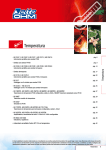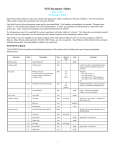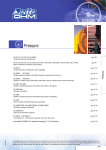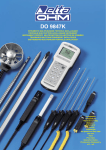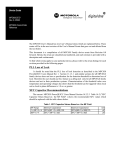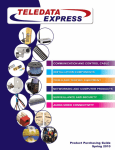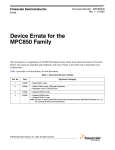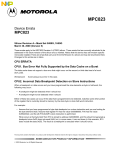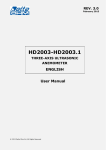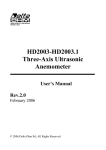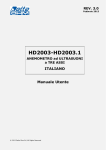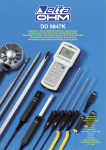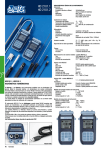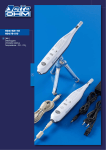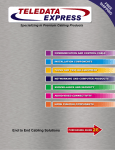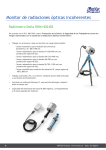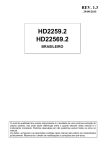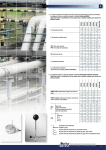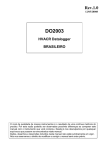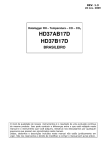Download HD 2102.1 HD 2102.2
Transcript
HD 2102.1 HD 2102.2 INSTRUMENT TECHNICAL CHARACTERISTICS Instrument Dimensions (Length x Width x Height) 185x90x40mm Weight 470g (complete with batteries) Materials ABS, rubber Display 2x4½ digits plus symbols - 52x42mm Visible area: 52x42mm Operating conditions Operating temperature Storage temperature Working relative humidity Protection degree -5…50°C -25…65°C 0…90%RH without condensation IP67 Power Batteries Autonomy Power absorbed with instrument off Mains 4 1.5V type AA batteries 200 hours with 1800mAh alkaline batteries 20μA Output mains adapter 12Vdc / 1000mA Measuring unit lux - fcd - lux/s - cd/s - W/m2 - µW/cm2 J/m2 - µJ/cm2 - µmol(m2.s) - µmol/m2 - cd/m2 Security of memorized data tions Time Date and time Accuracy Unlimited, independent of battery charge condi- Schedule in real time 1min/month max drift Measured values storage - model HD2102.2 Type 2000 pages containing 19 samples each Quantity Total of 38000 samples Storage interval 1s…3600s (1hour) Serial interface RS232C Type Baud rate Data bit Parity Stop bit Flow Control Serial cable length Immediate print interval HD2102.1 AND HD2102.2 PHOTO-RADIOMETERS The HD2102.1 and HD2102.2 are portable instruments with a large LCD display. They measure illuminance, luminance, PAR and irradiance (across VIS-NIR, UVA, UVB and UVC spectral regions or measurement of irradiance effective according to the UV action curve). The probes are fitted with the SICRAM automatic detection module: in addition to detection, the unit of measurement selection is also automatic. The factory calibration data are already stored inside the instruments. In addition to instantaneous measurement the instruments calculate the acquired measurements time integral Q(t). Some thresholds can be associated with the integrated measurement and with the integration time, which can be set in the menu. When exceeded these thresholds cause the instrument to stop the integral calculation. The HD2102.2 instrument is a datalogger. It stores up to 38,000 samples which can be transferred from the instrument connected to a PC via the multi-standard RS232C serial port and USB 2.0. The storing interval, printing, and baud rate can be configured using the menu. The HD2102.1 and HD2102.2 models are fitted with an RS232C serial port and can transfer the acquired measurements in real time to a PC or to a portable printer. The Max, Min and Avg function calculate the maximum, minimum or average values. Other functions include: the relative measurement REL, the HOLD function, and the automatic turning off that can also be excluded. The instruments have IP67 protection degree. USB interface - model HD2102.2 Type Connections Input module for the probes Serial interface and USB Mains adapter RS232C electrically isolated Can be set from 1200 to 38400 baud 8 None 1 Xon/Xoff Max 15m 1s…3600s (1hour) 1.1 - 2.0 electrically isolated 8-pole male DIN45326 connector 8-pole MiniDin connector 2-pole connector (positive at centre) Technical characteristics of photometric and radiometric probes complete with SICRAM module equipped with the instruments ILLUMINANCE measurement probe LP 471 PHOT Measurement range (lux): Resolution (lux): Spectral range: Class 0.01…199.99 …1999.9 0.01 0.1 1 C (B on request) <3% f3 (linearity): <1% f5 (fatigue): α (temp. coefficient) f6 (T) Drift after 1 year: Functioning temperature: Reference Standards 0.01⋅103 in agreement with standard photopic curve V(λ) Calibration uncertainty: f’1 (in agreement with photopic response V(λ)): f2 (response according to the cosine law): f4 (instrument reading error): …19999 …199.99⋅103 <4% <8% <0.5% <0.5% <0.05%K <1% 0…50°C CIE n.69 - UNI 11142 Photometric probe for illuminaNCE measurement, spectral response in agreement with standard photopic vision, diffuser for cosine correction. Measurement range: 0.01 lux…200⋅103 lux. CIE69, UNI11142 HD40.1 158 Light SWD10 LUMINANCE measurement probe LP 471 LUM 2 Measurement range (cd/m2): 0.1…1999.9 …19999 …199.99⋅103 …1999.9⋅103 2 Resolution (cd/m ): 0.1 1 0.1⋅103 0.01⋅103 Optical angle: 2° Spectral range: in agreement with standard photopic curve V(λ) Class C Calibration uncertainty: <5% f’1 (in agreement with photopic <8% response V(λ)): f3 (linearity): <1% f4 (instrument reading error): <0.5% f5 (fatigue): <0.5% <0.05%K α (temp. coefficient) f6 (T) Drift after 1 year: <1% Functioning temperature: 0…50°C Reference Standards CIE n.69 - UNI 11142 Photometric probe for luminance measurement, spectral response in agreement with standard photopic vision, vision angle 2°. Measurement range: 0.1 cd/m2…2000⋅103 cd/m2. IRRADIANCE measurement probe LP 471 RAD 1.000 20.00 0.1⋅10-3 Measurement range (W/m2): …19.999 …199.99 … 999.9⋅10-3 Resolution (W/m2): 0.001 0.01 0.1⋅10-3 Spectral range: 400nm…1050nm Calibration uncertainty: <5% f3 (linearity): <1% f4 (instrument reading error): ±1digit f5 (fatigue): <0.5% Drift after 1 year: <1% Working temperature: 0…50°C Radiometric probe for IRRADIANCE measurement in the spectral range 400nm…1050nm, diffuser for cosine correction. Measurement range: 0.1⋅10-3W/m2 …2000 W/m2. Typical response curve: LP 471 RAD Typical response curve: LP 471 PHOT and LP 471 LUM2 1 1 0,9 0,9 0,8 0,8 0,7 Relative spectral response 0,7 0,6 0,5 0,4 0,3 0,6 0,5 0,4 0,3 0,2 0,2 0,1 0,1 0 380 430 480 530 580 630 680 730 780 0 350 830 450 550 650 0.01 Resolution (μmol/m s ): -2 -1 0.1 Spectral range: 1 Calibration uncertainty: <5% f3 (linearity): <1% f4 (instrument reading error): ±1digit f5 (fatigue): <0.5% Drift after 1 year: Working temperature: IRRADIANCE measurement probe LP 471 UVA 1.000 20.00 0.1⋅10-3 …199.99 … 999.9⋅10-3 …19.999 0.001 0.01 0.1⋅10-3 Resolution (W/m2): 200.0 …1999.9 0.1 <5% f3 (linearity): <1% f4 (instrument reading error): ±1digit f5 (fatigue): <0.5% Drift after 1 year: <2% Working temperature: 0…50°C 1050 315nm…400nm (Peak 360nm) Calibration uncertainty: <1% 950 Measurement range (W/m2): Spectral range: 400nm…700nm 850 λ (nm) λ (nm) Quantum radiometric probe for the measurement of the photon flow across the chlorophyll range PAR LP 471 PAR 0.01… 199.99 200.0…1999.9 2000…10000 Measurement range (μmol/m-2s-1): 750 Light Relative spectral response 200.0 …1999.9 0.1 0…50°C Radiometric probe for IRRADIANCE measurement, in the 315nm…400nm, peak 360nm, UVA spectral range. Measurement range: 0.1⋅10‑3W/m2…2000 W/m2. Quantum radiometric probe for the measurement of the photon flow across the chlorophyll range PAR (Photosynthetically Active Radiation 400nm…700nm), measurement in μmol/m2s. Measurement range: 0.01μmol/m-2s-1…10⋅103μmol/m-2s-1. Typical response curve: LP 471 UVA Typical response curve: LP 471 PAR 1 0,7 0,9 PAR 0,8 0,5 Relative spectral response Relative spectral response Relative spectral response 0,6 0,4 0,3 0,2 0,7 0,6 0,5 0,4 0,3 0,2 0,1 0,1 0 350 400 450 500 550 600 λ (nm) 650 700 750 800 850 0 280 300 320 340 360 380 400 420 λ (nm) Light 159 IRRADIANCE measurement probe LP 471 UVB 1.000 20.00 0.1⋅10-3 Measurement range (W/m2): …199.99 … 999.9⋅10-3 …19.999 Resolution (W/m2): 0.001 0.01 0.1⋅10-3 Spectral range: 200.0 …1999.9 0.1 280nm…315nm (Peak 305nm) Calibration uncertainty: <5% f3 (linearity): <2% f4 (instrument reading error): ±1digit f5 (fatigue): <0.5% Drift after 1 year: Spectral range: UV action curve for erythema measurement (250nm…400nm) Calibration uncertainty: f3 (linearity): f4 (instrument reading error f5 (fatigue): Drift after 1 year Working temperature: Reference standard <2% Working temperature: Measurement probe LP 471ERY of TOTAL EFFECTIVE irradiANCE (W/m2) according to the UV action curve UV (CEI EN 60335-2-27) 1.000 20.00 200.0 0.1⋅10-3 Measurement range (Weff /m2): …199.99 …1999.9 … 999.9⋅10-3 …19.999 Resolution (Weff /m2): 0.001 0.01 0.1 0.1⋅10-3 0…50°C <15% <3% ±1digit <0.5% <2% 0…50°C CEI EN 60335-2-27 Radiometric probe for IRRADIANCE measurement, in the spectral range 280nm…315nm, peak 305nm, UVB. Measurement range: 0.1⋅10‑3W/m2…2000 W/m2. Radiometric probe for EFFECTIVE TOTAL IRRADIANCE (Weff /m2) according to the UV action curve (CIE EN 60335-2-27). Spectral range: 250 nm…400 nm, Measurement range: 0.1⋅10‑3Weff /m2 … 2000 Weff /m2 Typical response curve: LP 471 UVB Typical response curve: LP 471 ERY 10 Relative spectral response 1 1 0,9 Relative spectral response 0,8 0,7 0,6 0,00001 250 0,3 0,1 260 270 280 290 300 310 320 330 340 350 λ (nm) IRRADIANCE measurement probe LP 471 UVC 1.000 20.00 0.1⋅10-3 Measurement range (W/m2): …19.999 …199.99 … 999.9⋅10-3 0.001 0.01 Resolution (W/m2): 0.1⋅10-3 Spectral range: 200.0 …1999.9 0.1 220nm…280nm (Peak 260nm) Calibration uncertainty: <5% f3 (linearity): <1% f4 (instrument reading error): ±1digit f5 (fatigue): <0.5% Drift after 1 year: <2% Working temperature: 0…50°C Radiometric probe for IRRADIANCE measurement, in the spectral range 220nm…280nm, peak 260nm, UVC. Measurement range: 0.1⋅10‑3W/m2…2000 W/m2. Typical response curve: LP 471 UVC 1 0,9 0,8 Relative spectral response 270 290 310 330 350 370 390 λ (nm) 0,2 0,7 0,6 0,5 0,4 0,3 0,2 0,1 210 220 230 240 250 λ (nm) 160 Light 0,001 Continuous line = UV action curve Dotted line = Spectral sensitivity probe LP471ERY 0,4 0 200 0,01 0,0001 0,5 0 250 0,1 260 270 280 290 300 The probe LP 471 ERY measures the effective total irradiance (Weff /m2) according to the UV action curve (CEI EN 60335-2-27). A particular type of photodiode and a combination of special filters bring the spectral response closer to the UV action curve. CEI EN 60335-2-27 standards estabilish a maximum allowable dose of 100J/m2 for first-time exposure and an annual dose of 15000J/m2. The typical spectral response curve of LP 471 ERY is shown in the Figure together with the UV action curve. The good accordance between the two curves enables the instrument to take reliable measurements of different types of lamps (and filters) used at present for tonning machines. PURCHASING CODES HD2102.1: The kit consists of the instrument HD2102.1, 4 1.5V alkaline batteries, operating manual, case and DeltaLog9 software. Probes and cable must be ordered separately. HD2102.2: The kit consists of the HD2102.2 datalogger, 4 1.5V alkaline batteries, operating manual, case and DeltaLog9 software. Probes and cable must be ordered separately. HD2110CSNM: 8-pole connection cable MiniDin - Sub D 9-pole female for RS232C. HD2101/USB: Connection cable USB 2.0 connector type A - 8-pole MiniDin. DeltaLog9: Software for download and management of the data on PC using Windows 98 to Vista operating systems. SWD10: Stabilized power supply at 230Vac/12Vdc-1000mA mains voltage. HD40.1: On request, portable, serial input, 24 column thermal printer, 58mm paper width. Probes complete with SICRAM module LP 471 PHOT: Photometric probe for illuminaNCE measurement complete with SICRAM module, spectral response in agreement with standard photopic vision, diffuser for cosine correction. Measurement range: 0.01 lux…200⋅103 lux. LP 471 LUM 2: Photometric probe for luminance measurement complete with SICRAM module, spectral response in agreement with standard photopic vision, vision angle 2°. Measurement range: 0.1 cd/m2…2000⋅103 cd/m2. LP 471 PAR: Quantum radiometric probe for the measurement of the photon flow across the chlorophyll range PAR (Photosynthetically Active Radiation 400nm…700nm) complete with SICRAM, measurement in μmol/m-2s-1, diffuser for cosine correction. Measurement range: 0.01μmol/m-2s-1…10⋅103μmol/m-2s-1. LP 471 RAD: Radiometric probe for IRRADIANCE measurement complete with SICRAM module; in the 400nm…1050nm spectral range, diffuser for cosine correction. Measurement range: 0.1⋅10-3W/m2 …2000 W/m2. LP 471 UVA: Radiometric probe for IRRADIANCE measurement complete with SICRAM module; in the 315nm…400nm, peak 360nm, UVA spectral range, quartz diffuser for cosine correction. Measurement range: 0.1⋅10‑3W/m2…2000 W/m2. LP 471 UVB: Radiometric probe for IRRADIANCE measurement complete with SICRAM module, in the 280nm…315nm, peak 305nm, UVB spectral range, quartz diffuser for cosine correction. Measurement range: 0.1⋅10‑3W/m2…2000 W/m2. LP 471 UVC: Radiometric probe for IRRADIANCE measurement complete with SICRAM module, in the 220nm…280nm, peak 260nm, UVC spectral range, quartz diffuser for cosine correction. Measurement range: 0.1⋅10‑3W/m2…2000 W/m2. LP 471 ERY: Radiometric probe for EFFECTIVE TOTAL IRRADIANCE (Weff /m2) according to the UV action curve (CEI EN 60335-2-27) complete with SICRAM module. Spectral range: 250 nm…400 nm, quartz diffuser for cosine correction. Measurement range: 0.1⋅10‑3Weff /m2 … 2000 Weff /m2. LP BL: Base with levelling device (except LP 471 LUM 2). HD 2302.0 Technical characteristics of photometric and radiometric probes complete with SICRAM module equipped with the instruments ILLUMINANCE measurement probe LP 471 PHOT Measurement range (lux): 0.01…199.99 …1999.9 Resolution (lux): 0.01 Spectral range: …19999 …199.99⋅103 0.1 1 0.01⋅103 in agreement with standard photopic curve V(λ) Class C Calibration uncertainty: f’1 (in agreement with photopic response V(λ)): f2 (response according to the cosine law): <4% <3% f3 (linearity): <1% <8% f4 (instrument reading error): <0.5% f5 (fatigue): <0.5% α (temp. coefficient) f6 (T) <0.05%K Drift after 1 year: <1% Functioning temperature: 0…50°C Reference Standards CIE n.69 - UNI 11142 Photometric probe for illuminaNCE measurement, spectral response in agreement with standard photopic vision, diffuser for cosine correction. Measurement range: 0.01 lux…200⋅103 lux. LUMINANCE measurement probe LP 471 LUM 2 Measurement range (cd/m2): 0.1…1999.9 …19999 …199.99⋅103 …1999.9⋅103 0.1 1 0.01⋅10 0.1⋅103 Resolution (cd/m ): 2 3 Optical angle: 2° Spectral range: in agreement with standard photopic curve V(λ) C Calibration uncertainty: f’1 (in agreement with photopic response V(λ)): f3 (linearity): HD2302.0 PHOTO-RADIOMETER <5% <8% <1% f4 (instrument reading error): <0.5% f5 (fatigue): The HD2302.0 is a portable instrument with a large LCD display. It measures illuminance, luminance, PAR and irradiance (across VIS-NIR, UVA, UVB and UVC spectral regions or measurement of irradiance effective according to the UV action curve). The probes are equipped with the SICRAM automatic detection module: in addition to detection, the unit of measurement selection is also automatic. The factory calibration data are already memorized inside the instruments. The Max, Min and Avg function calculate the maximum, minimum or average values. Other functions include: the relative measurement REL, the HOLD function, and the automatic turning off that can also be excluded. The instruments have IP67 protection degree. INSTRUMENT TECHNICAL CHARACTERISTICS Instrument Dimensions (Length x Width x Height) 140x88x38mm Weight 160g (complete with batteries) Materials ABS Display 2x4½ digits plus symbols - 52x42mm Visible area: 52x42mm Light Class <0.5% α (temp. coefficient) f6 (T) <0.05%K Drift after 1 year: <1% Functioning temperature: 0…50°C Reference Standards CIE n.69 - UNI 11142 Photometric probe for luminance measurement, spectral response in agreement with standard photopic vision, vision angle 2°. Measurement range: 0.1 cd/m2…2000⋅103 cd/m2. Typical response curve: probe LP 471 PHOT, LP 471 LUM2 1 0,9 -5…50°C -25…65°C 0…90%RH without condensation IP67 Power Batteries 3 1.5V type AA batteries Autonomy 200 hours with 1800mAh alkaline batteries Power absorbed with instrument off 20μA Measuring unit Connections Input module for the probes lux - fcd - µmol/m2.s - cd/m2 - W/m2 - µW/cm2 8-pole male DIN45326 connector 0,8 Relative spectral response Operating conditions Operating temperature Storage temperature Working relative humidity Protection degree 0,7 0,6 0,5 0,4 0,3 0,2 0,1 0 380 430 480 530 580 630 680 730 780 830 λ (nm) Light 161 Quantum radiometric probe for the measurement of the photon flow across the chlorophyll range PAR LP 471 PAR 0.01… 199.99 200.0…1999.9 2000…10000 Measurement range (μmol/m-2s-1): 0.01 Resolution (μmol/m-2s-1): 0.1 Spectral range: 1 400nm…700nm IRRADIANCE measurement probe LP 471 UVA 1.000 20.00 0.1⋅10-3 Measurement range (W/m2): …199.99 … 999.9⋅10-3 …19.999 Resolution (W/m2): 0.001 0.01 0.1⋅10-3 Spectral range: 315nm…400nm (Peak 360nm) Calibration uncertainty: <5% Calibration uncertainty: <5% f3 (linearity): <1% f3 (linearity): <1% f4 (instrument reading error): ±1digit f4 (instrument reading error): ±1digit f5 (fatigue): <0.5% f5 (fatigue): <0.5% Drift after 1 year: <1% Working temperature: Drift after 1 year: 0…50°C <2% Working temperature: Quantum radiometric probe for the measurement of the photon flow across the chlorophyll range PAR (Photosynthetically Active Radiation 400nm…700nm), measurement in μmol/m-2s-1. Measurement range: 0.01μmol/m2s-1…10⋅103μmol/m2s. 200.0 …1999.9 0.1 0…50°C Radiometric probe for IRRADIANCE measurement, in the 315nm…400nm, peak 360nm, UVA spectral range. Measurement range: 0.1⋅10‑3W/m2…2000 W/m2. Typical response curve: probe LP 471 UVA Typical response curve: probe LP 471 PAR 1 0,9 0,7 Relative spectral response Relative spectral response Relative spectral response 0,8 PAR 0,6 0,5 0,4 0,3 0,2 0,7 0,6 0,5 0,4 0,3 0,2 0,1 0,1 0 280 0 350 400 450 500 550 600 650 700 750 800 850 300 320 340 IRRADIANCE measurement probe LP 471 RAD 1.000 20.00 0.1⋅10-3 Measurement range (W/m2): …19.999 …199.99 … 999.9⋅10-3 Resolution (W/m2): 0.001 0.01 0.1⋅10-3 Spectral range: 200.0 …1999.9 0.1 400nm…1050nm Calibration uncertainty: <5% f3 (linearity): <1% f4 (instrument reading error): ±1digit f5 (fatigue): <0.5% Drift after 1 year: Working temperature: <2% f4 (instrument reading error): ±1digit f5 (fatigue): <0.5% 1 0,9 0,9 0,8 0,8 0,7 0,7 0,6 0,5 0,4 0,3 0,5 0,4 0,3 0,2 0,1 0,1 750 λ (nm) 162 Light <2% 0…50°C 0,6 0,2 650 200.0 …1999.9 0.1 Typical response curve: probe LP 471 UVB 1 550 420 Radiometric probe for IRRADIANCE measurement, in the spectral range 280nm…315nm, peak 305nm, UVB. Measurement range: 0.1⋅10‑3W/m2…2000 W/m2. Relative spectral response a Relative spectral response <5% f3 (linearity): Working temperature: Typical response curve: probe LP 471 RAD 450 400 280nm…315nm (Peak 305nm) Calibration uncertainty: Drift after 1 year: 0…50°C Radiometric probe for IRRADIANCE measurement in the spectral range 400nm…1050nm, diffuser for cosine correction. Measurement range: 0.1⋅10-3W/m2 …2000 W/m2. 0 350 380 IRRADIANCE measurement probe LP 471 UVB 1.000 20.00 0.1⋅10-3 Measurement range (W/m2): …199.99 … 999.9⋅10-3 …19.999 Resolution (W/m2): 0.001 0.01 0.1⋅10-3 Spectral range: <1% 360 λ (nm) λ (nm) 850 950 1050 0 250 260 270 280 290 300 λ (nm) 310 320 330 340 350 IRRADIANCE measurement probe LP 471 UVC 1.000 20.00 0.1⋅10-3 Measurement range (W/m2): …19.999 …199.99 … 999.9⋅10-3 0.001 0.01 Resolution (W/m2): 0.1⋅10-3 200.0 …1999.9 0.1 220nm…280nm (Peak 260nm) Calibration uncertainty: <5% f3 (linearity): <1% f4 (instrument reading error): ±1digit f5 (fatigue): <0.5% Drift after 1 year: ORDER CODES HD2302.0: The kit consists of the instrument HD2302.0, 3 1.5V alkaline batteries, operating manual, case. The probes must be ordered separately. <2% Working temperature: 0…50°C Radiometric probe for IRRADIANCE measurement, in the spectral range 220nm…280nm, peak 260nm, UVC. Measurement range: 0.1⋅10‑3W/m2…2000 W/m2. Typical response curve: probe LP 471 UVC 1 0,9 Relative spectral response 0,8 0,7 0,6 0,5 0,4 0,3 0,2 0,1 0 200 210 220 230 240 250 260 270 280 290 300 λ (nm) Measurement probe LP 471ERY of TOTAL EFFECTIVE irradiANCE (W/m2) according to the UV action curve UV (CEI EN 60335-2-27) 1.000 20.00 200.0 0.1⋅10-3 Measurement range (Weff /m2): …199.99 …1999.9 … 999.9⋅10-3 …19.999 Resolution (Weff /m2): 0.001 0.01 0.1 0.1⋅10-3 Spectral range: UV action curve for erythema measurement (250nm…400nm) Calibration uncertainty: <15% f3 (linearity): <3% f4 (instrument reading error ±1digit f5 (fatigue): <0.5% Drift after 1 year Probes equipped with SICRAM module LP 471 PHOT: Photometric probe for illuminaNCE measurement complete with SICRAM module, spectral response in agreement with standard photopic vision, diffuser for cosine correction. Measurement range: 0.01 lux…200⋅103 lux. LP 471 LUM 2: Photometric probe for luminance measurement complete with SICRAM module, spectral response in agreement with standard photopic vision, vision angle 2°. Measurement range: 0.1 cd/m2…2000⋅103 cd/m2. LP 471 PAR: Quantum radiometric probe for the measurement of the photon flow across the chlorophyll range PAR (Photosynthetically Active Radiation 400nm…700nm) complete with SICRAM, measurement in μmol/m-2s-1, diffuser for cosine correction. Measurement range: 0.01μmol/m-2s-1…10⋅103μmol/m-2s-1. LP 471 RAD: Radiometric probe for IRRADIANCE measurement complete with SICRAM module; in the 400nm…1050nm spectral range, diffuser for cosine correction. Measurement range: 0.1⋅10-3W/m2 …2000 W/m2. LP 471 UVA: Radiometric probe for IRRADIANCE measurement complete with SICRAM module; in the 315nm…400nm, peak 360nm, UVA spectral range, quartz diffuser for cosine correction. Measurement range: 0.1⋅10‑3W/m2…2000 W/m2. LP 471 UVB: Radiometric probe for IRRADIANCE measurement complete with SICRAM module, in the 280nm…315nm, peak 305nm, UVB spectral range, quartz diffuser for cosine correction. Measurement range: 0.1⋅10‑3W/m2…2000 W/m2. LP 471 UVC: Radiometric probe for IRRADIANCE measurement complete with SICRAM module, in the 220nm…280nm, peak 260nm, UVC spectral range, quartz diffuser for cosine correction. Measurement range: 0.1⋅10‑3W/m2…2000 W/m2. LP 471 ERY: Radiometric probe for TOTAL EFFECTIVE IRRADIANCE (Weff/m2) according to the UV action curve (CEI EN 60335-2-27) complete with SICRAM module. Spectral range: 250 nm…400 nm, quartz diffuser for cosine correction. Measurement range: 0.1⋅10‑3Weff /m2 … 2000 Weff /m2. LP BL: Base with levelling device for the probes (except LP 471 LUM 2). <2% Working temperature: 0…50°C Reference standard CEI EN 60335-2-27 Radiometric probe for EFFECTIVE TOTAL IRRADIANCE (Weff /m2) according to the UV action curve (CIE EN 60335-2-27). Spectral range: 250 nm…400 nm, Measurement range: 0.1⋅10‑3Weff /m2 … 2000 Weff /m2 Typical response curve: TOTAL EFFECTIVE IRRADIANCE probe LP 471 ERY 10 Continuous line = UV action curve Dotted line = Spectral sensitivity probe LP471ERY Relative spectral response 1 0,1 0,01 0,001 0,0001 0,00001 250 270 290 310 330 350 370 390 λ (nm) Light 163 Light Spectral range: The probe LP 471 ERY measures the total effective irradiance (Weff/m2) according to the UV action curve (CEI EN 60335-2-27). A particular type of photodiode and a combination of special filters bring the spectral response closer to the UV action curve. CEI EN 60335-2-27 standards estabilish a maximum allowable dose of 100J/m2 for first-time exposure and an annual dose of 15000J/m2. The typical spectral response curve of LP 471 ERY is shown in the Figure together with the UV action curve. The good accordance between the two curves enables the instrument to take reliable measurements of different types of lamps (and filters) used at present for tanning machines. Calibration is performed at 290nm using a SIT calibrated photodiode as reference. PHOTOMETRIC AND RADIOMETRIC PROBES FOR PORTABLE INSTRUMENTS Code Description LP471PHOT Photometric probe for illuminaNCE measurement, spectral response in agreement with standard photopic vision, diffuser for cosine correction. Measurement range: 0.01 lux…200⋅103 lux. CIE69, UNI11142 38 Ø 30 LP471LUM2 Photometric probe for luminance measurement, spectral response in agreement with standard photopic vision, vision angle 2°. Measurement range: 0.1 cd/m2…2000⋅103 cd/m2. 160 Ø 40 LP471PAR Quantum radiometric probe for the measurement of the photon flow across the chlorophyll range PAR (Photosynthetically Active Radiation 400nm…700nm), measurement in μmol/m-2s-1. Measurement range: 0.01μmol/m-2s-1…10⋅103μmol/m-2s-1. 38 Ø 30 LP471RAD Radiometric probe for IRRADIANCE measurement in the spectral range 400nm…1050nm, diffuser for cosine correction. Measurement range: 0.1⋅10-3W/m2 …2000 W/m2. 38 Ø 30 LP471UVA Radiometric probe for IRRADIANCE measurement, in the 315nm…400nm, peak 360nm, UVA spectral range. Measurement range: 0.1⋅10‑3W/m2…2000 W/m2. 38 Ø 30 LP471UVB Radiometric probe for IRRADIANCE measurement, in the spectral range 280nm…315nm, peak 305nm, UVB. Measurement range: 0.1⋅10‑3W/m2…2000 W/m2. 38 Ø 30 LP471UVC Radiometric probe for IRRADIANCE measurement, in the spectral range 220nm…280nm, peak 260nm, UVC. Measurement range: 0.1⋅10‑3W/m2…2000 W/m2. 38 Ø 30 LP471ERY Radiometric probe for EFFECTIVE TOTAL IRRADIANCE (Weff /m2) according to the UV action curve (CIE EN 60335-2-27). Spectral range: 250 nm…400 nm, Measurement range: 0.1⋅10‑3Weff /m2 … 2000 Weff /m2 38 Ø 30 LP BL 164 Light Base with levelling device. On request for assembly with the probes at the time of order. (not for LUM probes) DO 9721 INSTRUMENT TECHNICAL DATA Inputs / type of measurement 2: Connector Measuring range Photometric measurements Radiometric measurements Q energy Integration time No. conversions per second Working temperature Working relative humidity Serial output lated) Display Functions Memory Power supply Autonomy Weight / dimensions photometric / radiometric or temperature DIN 45326 8-pole 0...200.000 lux 0...20.000 fcd 0...2.000.000 cd/m2 0...2000 W/m2 0...200.000 µW/cm2 0...200.000 µmol/m-2s-1 depends on the active measurements unit 19 hours, 59 minutes, 59 seconds 2 -5...+50°C 0...90% R.H. (no condensation) RS232C 300...19200 baud (galvanically insuDouble LCD 12.5 mm Auto power off / Autorange / Hold / Record / Maximum / Minimum / Mean / Relative / A-B / Energy 512kB (FLASH) corr. to 30,000 measurements 9Vdc alkaline battery Approx. 30 hours (continuous duty) 320 gr. / 215x73x38 mm 38 DO9721 Quantum PHOTO-RADIOMETER AND THERMOMETER DATA-LOGGER The DO 9721 quantum photo-radiometer and thermometer data logger has been designed for measuring illuminance, irradiance, luminance and temperature. The instrument has two inputs, A and B, and automatically detects the sensors, whether illuminance, irradiance, luminance or temperature and can provide a view of the difference between the two inputs. As the probes are interchangeable, it is possible to choose the most suitable combination for all applications without having to recalibrate the instrument. The DO 9721 is able to take illuminance measurements in lux and in fcd (foot-candle), irradiance measurements in W/m2, in µW/cm2 e in µmol/m-2s-1, luminance measurements in cd/m2 and temperature measurements in °C or °F. The function of the instrument data logger stores up to 30,000 readings with selectable sampling interval from 1 second to 12 hours. The data acquired can then be downloaded to a Personal Computer or a printer by means of the optoinsulated serial line RS232C. For each value stored the date and time of acquisition are indicated; each acquisition block is ended with a report which provides the maximum, minimum and mean values. With the Serial Output function it is possible to obtain the instantaneous values measured by the instrument at the output of the serial line RS232C, in order to send them to a printer or a computer. Other functions such as Hold (which blocks the display), Rel (for taking relative measurements), Record (for storing the maximum, minimum and mean values) and Q (integration in time of the measurements with alarm threshold) further enrich the instrument’s performance. Thanks to its versatility and to its storage capacity, the instrument is suitable for a wide variety of applications, both in the field and in the laboratory. LP 9021 PHOT: Photometric probe for measuring light, ILLUMINANCE, photopic filter complying with CIE, diffuser for correction according to the cosine law. Ø 40 LP 9021 RAD: Radiometric probe for measuring the IRRADIANCE of artificial light sources, irradiance of the sun. 38 Ø 40 38 LP 9021 PAR: Radiometric probe for measuring IRRADIANCE in the region of PAR radiations (Photosynthetically Active Radiation); it works in the field of the chlorophyll process following a special response curve. Ø 40 PROBE CONNECTION The instrument DO 9721 has two circular DIN 45326 8-pole connectors (A and B) which allow the connection of Delta Ohm probes for measuring temperature, type TP 870, and probes for measuring the photometric and radiometric intensity, type LP 9021. The probe model should be chosen according to the specific application; see the section on accessories. 38 LP 9021 UVA: Radiometric probe for measuring IRRADIANCE in the ultraviolet field. Suitable for measuring radiation in the ultraviolet region A. Ø 40 Light 165 Light ORDER CODES DO 9721: Basic instrument kit, diplomatic carrying case, instrument, CP RS232C serial connecting cable, 9V battery. The probes and cables must be ordered separately. 38 LP 9021 UVB: Radiometric probe for measuring IRRADIANCE in the ultraviolet field. Suitable for measuring radiation in the ultraviolet region B. 38 Ø 40 LP 9021 ERY: Radiometric probe for TOTAL EFFECTIVE IRRADIANCE (Weff/m2) according to the UV action curve (CEI EN 603352-27) complete with SICRAM module. Spectral range: 250 nm…400 nm, quartz diffuser for cosine correction. Measurement range: 0.1⋅10‑3Weff /m2 … 2000 Weff /m2. Ø 40 38 LP 9021 UVC: Radiometric probe for measuring IRRADIANCE in the ultraviolet field. Suitable for measuring radiation in the ultraviolet region C. Ø 40 LP BL: Stand for supporting and levelling probes, eccept for LP 9021 LUM6. TP 870: Immersion temperature probe, Pt100 sensor, diam. 3x230 mm, measuring range -50...+400°C. TP 870/C: Contact temperature probe, Pt100 sensor, diam. 4x230 mm, measuring range -50...+400°C. TP 870/P: Penetration temperature probe, Pt100 sensor, diam. 4x150 mm, measuring range -50...+400°C. TP 870/A: Air temperature probe, Pt100 sensor, diam. 4x230 mm, measuring range -50...+250°C. Ø 40 158 LP 9021 LUM6: Probe for measuring LUMINANCE, measuring range from 1 to 1999 x 103 candles/ m2. Measuring angle 2°. CIE filter for correction of the response according to the human eye, CIE n°69-UNI11142 LP BL Probe types Measuring range Spectral range Calibration uncertainty LP 9021 PHOT 0.1÷200000 LUX CIE N°69 Classe C <4% LP 9021 RAD 1 mW/m2÷2000 W/m2 450÷950 nm <5% LP 9021 PAR 0.1 μmol m-2s-1÷20000 μmol m-2s-1 400÷700 nm <5% LP 9021 UVA 1 mW/m2÷2000 W/m2 315÷400 nm <5% LP 9021 UVB 2 1 mW/m ÷2000 W/m 280÷315 nm <5% LP 9021 UVC 1 mW/m2÷2000 W/m2 200÷280 nm <5% LP 9021 LUM6 1÷2 x 106 cd/m2 CIE N°69 Classe C <5% LP 9021 ERY 0.1.10-3 Weff/m2 2000 Weff/m2 250 mm÷400 mm <15% Uncertainty of the instrument at 25°C +/0.1% + 1 digit 0.6°C 0.4°C 2°C 2 Temperature measurement instrument in line with probe ACCURACY INSTRUMENT from -5°C till 50°C +/0.2% + 1 digit 0.6°C + 0.01°C/°C 0.4°C + 0.01°C/°C 2°C + 0.01°C/°C Measuring range +/-50 ... +50°C +50 ... +200°C +200 ... +400°C TEMPERATURE PROBES TP870 τ Sec. Temp/°C Immersion probe Ø 3 x 230 mm 3”A -50/+400 TP 870/P Penetration probe Ø 4 x 150 mm 3”A -50/+400 TP 870/C Contact probe Ø 4 x 230 mm 12”C -50/+400 TP 870/A Air probe Ø 4 x 230 mm 3”B -50/+250 CODE Description TP 870 Drawing A) Time constant in water at 100°C / B) Time constant observed with metal surface at 200°C / C) Time constant in air at 100°C Note: The time constant is the time needed to respond to 63% of the temperature changes. 166 Light 19 2 20 3 21 4 22 5 23 6 24 7 25 8 26 9 27 10 28 11 29 12 30 13 31 14 32 15 33 16 34 17 35 1 Input A, DIN 45326 8-pole connector. 2 HOLD symbol, the measurement refers to the moment in which the HOLD key was pressed. 3 Battery symbol: flashes during RECORD function, permanently lit if the battery is running low. 4 REL symbol, indicates that the instrument is making a relative measurement. 5 Serial Out/Memory. Fixed symbol: the instrument is storing. Flashing symbol: serial output is enabled. 6 MED symbol: the display shows the mean values found during RCD function. 7 Q: instrument in Q-energy function, flashes when it has reached the limit. 8 Time: the display indicates the integration time, if flashing it has reached the time programmed for integration. 9 Lux: the led indicates that the measurement is in lux. 10µW/cm2: the led indicates that the measurement is in µW/cm2. 11µmol/m-2s-1: the led indicates that the measurement is in µmol m-2s-1. 12REL key: shows the difference between the current value and the value stored when the REL key is pressed. 13HOLD key for blocking the reading. 14Unit A key: for selecting the measurement unit for input A, depending on the probe fitted. When turned to P0 mode, it sets the Q-energy and Time limits for input A. 15Serial Output: activates data transmission at the RS232C serial output. 16▲ (Memory clear): increases the parameters in programming mode; when held down it erases the “RCD” memory; when pressed with P1, it erases the permanent memory. 17PROG key: activates the programs P0... P1... P... of the different instrument functions. 18Connector for RS232C (SUB D male 9 pole). 19Input B, DIN 45326 8-pole connector. 20Symbol 103: indicates multiplication factor 103 for the respective channel. 21Symbols A and B: for magnitudes Q and T indicate the channel selected. 22 A-B: the bottom display shows the difference between A and B. The top display shows A. 23MIN symbol: the display shows the minimum values found during RCD function. 24MAX symbol: the display shows the maximum values found during RCD function. 25°C: the led indicates that the temperature measurement is in degrees centigrade. 26°F: the led indicates that the temperature measurement is in degrees Fahrenheit. 27fcd: the led indicates that the measurement is in fcd (foot-candle). 28W/m2: the led indicates that the measurement is in W/m2. 29cd/m2: the led indicates that the measurement is in cd/m2. 30On/Off key: for switching the instrument on or off. 31Unit B key: for selecting the measurement unit for input B, depending on the probe fitted. When turned to P0 mode, it sets the Q-energy and Time limits for input B. 32A-B key: shows the difference between the inputs. 33Data Call key (Max-Min-Med-Q-Time): recalls on the display the maximum, mean, minimum, Q and Time values of each input. 34▼ (RCD): starts and stops the RECORD function, in programming mode it decreases the parameter shown. 35ENTER key: starts and stops storage, confirms the parameters set during programming. 18 A) Amplified temperature probe with Pt100 platinum-sensitive element Probe TP870 series 6 1 4 DO 9721 Instrument input 7 3 5 8 3 7 6 8 5 2 B A 1 4 GND OUT 2.375 mV/ C -5V Active probe Pt100 TP870 series 8 1 6 7 +5V 8 GND 1 IN 2.375 mV/ C 6 -5V 7 +5V 2 Probe Pt100 TP870 series input B) Probes for photometric and radiometric measurements Probe LP9021 series 6 1 4 7 3 5 8 3 6 8 B A 1 4 1 2 5 3 6 7 IN 0.5 V f.s. Range A Range B R sel GND +5V -5V Active probe LP9021 series 8 -5V 8 Range A 1 OUT 0.5 V f.s. 2 2 Range B R sel 3 5 GND +5V 6 7 5 2 7 DO 9721 Instrument input DO9721 active probe LP9021 series input Light 167 Light 1 LP PHOT 01 LP PAR 01 LP RAD 01 LP UVA 01 LP UVB 01 LP UVC 01 of Characterizing Illuminance Meters and Luminance Meteres”. The measurement is carried out by illuminating the probe with a standard illuminant A. TECHNICAL SPECIFICATIONS Typical sensitivity: Spectral range: Calibration accuracy: f’1 (V(λ) match error): f2 (cosine response/directional error): f3 (linearity’): f5 (fatigue): Operating temperature: Output impedance: 0.5 ÷1.5 mV/klux V(λ) <4% <8% <3% <1% <0.5% 0-50°C 0.5 ÷1 kΩ 38 Typical spectral response LP PHOT 01 Ø 40 LP RAD 01: 1 LP PHOT 01 0.9 Relative spectral response Relative spectral response 0.8 0.7 0.6 0.5 0.4 0.3 0.2 0.1 0 380 430 480 530 580 630 680 730 780 830 λ (nm) LP RAD 01 probe measures irradiance (W/m2 ) defined as the ratio between the radiant flux (W) passing through a surface and the surface area (m2) in the VIS-NIR (400nm1050nm) spectral range. These particular features apply to an instrument suitable for measurements in visible and near infrared fields. Probe calibration is carried out by using 577/579 nm lines of a Xe-Hg lamp, filtered through a special interferential filter. Probe description LP PHOT 01: LP PHOT 01 probe measures illuminance (lux) defined as the ratio between the luminous flux (lumen) passing through a surface and the surface area (m2). The spectral response curve of a photometric probe is similar to the human eye curve, known as standard photopic curve V(λ). The difference in spectral response between LP PHOT 01 and the standard photopic curve V(λ) is calculated by means of the error f1’. Calibration is carried out by comparison with a luxmeter, calibrated by a Primary Metrological Institute. Calibration procedures follow CIE publication No 69 (1987) “Method 168 Light 2.6 μV/(μW/cm2) 0-200 mW/cm2 ≈400nm ÷≈1050nm <6% <7% 0-50°C 1 kΩ 38 Typical spectral response LP RAD 01 Ø 40 LP RAD 01 1 ,0 Relative Spectral Response The LP…01 series allows measurement of Photometric and Radiometric quantities such as illuminance (lux), irradiance (W/m2) across VIS-NIR, UVA, UVB, UVC spectral regions, as well as the number of photons received per unit time on a unit area, in the Photosynthetical Active Radiation (PAR) wavelength range from 400nm - 700nm. In LP….01 probes, there is no need for external power supply. Output signal in mV is given through a resistor shunting the photodiode ends. Photocurrent generated by the photodiode when hit by light, is converted to a potential difference, which is read by a voltmeter. Once the DDP (Potential Difference) has been read, the measured value can be calculated through the calibration factor. All probes are individually calibrated and the calibration factor is shown both on the probe housing and on the user manual and is specific to that probe. LP…01 probes are equipped with cosine corrected diffuser. In probes for UV measurements the diffuser is made of sanded quartz, for the other probes, the diffuser is commonly made of acrylic material or teflon® (LP PHOT 01). LP ... .01 probes are suitable for applications in-door which requires the constant monitoring of the quantities specified. The output signal can be amplified or converted into a 4÷20mA or 0÷10Vdc signal by using a converter of the series HD978TR3 (4÷20mA) and HD978TR4 (0÷10Vdc) for DIN rail attachment, or the wall mounting types HD978TR5 (4÷20mA) and HD978TR6 (0÷10Vdc). Installing the probes Once you have chosen where to install the probe, you must provide the connections between the probe and the voltmeter; the volmeter must have proper scales of measurement. The connection diagram of the probe output cables is shown in the user manual. For measurements in weather and agriculture stations or in nursery-gardening systems, the probe reference plane should be mounted parallel to the ground; in this case, the probe shall be mounted on a LP BL (optional) support provided with bubble level. Relative spectral response LP PHOT 01, LP RAD 01, LP PAR 01, LP UVA 01, LP UVB 01, LP UVC 01 PHOTOMETRIC/RADIOMETRIC PROBES WITH mV SIGNAL OUTPUT TECHNICAL SPECIFICATIONS Typical sensitivity: Measuring range: Spectral range: Calibration accuracy: f2 (cosine response/directional error): Operating temperature: Output impedance: 0 ,8 0 ,6 0 ,4 0 ,2 0 ,0 350 450 550 650 750 850 950 1050 λ (n m ) LP UVA 01: LP UVA 01 probe measures irradiance (W/m2 ) defined as the ratio between the radiant flux (W) passing through a surface and the surface area (m2) in the UVA (315 nm ÷ 400 nm) spectral range. Thanks to a new type of photodiode, LP UVA 01 is blind to visible and infrared light. Probe calibration is carried out by using a 365 nm line of a Xe-Hg lamp, filtered through a special interferential filter. Measurement is carried out by comparison with the primary standards, assigned to Delta Ohm Metrological Laboratory. This probe can be used in all processes where ultraviolet lamp emission needs to be monitored: resins and adhesives polymerization, as well as tanning lamps. TECHNICAL SPECIFICATIONS Typical sensitivity: 2.6 μV/(μW/cm2) Measuring range: 0-200 mW/cm2 Typical spectral range: peak at ≈360 nm and FWHM 60 nm Calibration accuracy: <6% Working temperature: 0-50°C Output impedance: 1 kΩ Typical spectral response LP UVC 01 1 38 Relative spectral response Relative spectral response 0.8 Typical spectral response LP UVA 01 1 Ø 40 LP UVA 01 0.9 0.8 0.7 0.7 0.6 0.5 0.4 0.3 0.2 0.1 0.6 0 200 210 220 230 24 0 260 270 280 290 300 LP PAR 01: LP PAR 01 probe measures the ratio between the number of photons that strike a surface in one second, in the 400nm - 700nm spectral range and the surface area (m2). This quantity is defined as PAR: Photosynthetically Active Radiation. The probe calibration is carried out by using an alogen lamp, with a known spectral irradiance in a specific spectral range. Temperature slightly affects the probe spectral response. The diffuser and the probe particular structure, allow the response to the variation of the light incidence angle on the diffuser, to be cosine corrected 0.4 0.3 0.2 0.1 0 280 300 320 340 360 380 400 420 λ ( nm ) LP UVB 01: LP UVB 01 probe measures irradiance (W/m2 ) defined as the ratio between the radiant flux (W) passing through a surface and the surface area (m2) in the UVB (280 nm –315 nm) spectral range. Thanks to a new type of photodiode, LP UVB 01 is blind to visible and infrared light. Probe calibration is carried out by using a 313 nm line of a Xe-Hg lamp, filtered through a special interferential filter. Measurement is carried out by comparison with the primary standards, assigned to Delta Ohm Metrological Laboratory. TECHNICAL SPECIFICATIONS Typical sensitivity: Measuring range: Typical spectral range: Calibration accuracy: f2 (cosine response/directional error): Operating temperature: Output impedance: TECHNICAL SPECIFICATIONS Typical sensitivity: 0.19 μV/(μW/cm2) Measuring range: 0-200 mW/cm2 Typical spectral range: peak at ≈ 305 nm and FWHM 31 nm Calibration accuracy: <8% Working temperature: 0-50°C Output impedance: 2 kΩ Typical spectral response LP PAR 01 30 μV/(μmol/(m-2s-1) 0-5000 (μmol/(m-2s-1) 400 nm ÷ 660 nm <6% <7% 0-50°C 1 kΩ 38 Ø 40 0,7 38 Relative spectral response Ø 40 LP UVB 01 0.9 PAR 0,6 Relative spectral response Typical spectral response LP UVB 01 1 250 λ ( nm ) 0.5 Light Relative spectral response Relative spectral response LP UVC 01 0.9 0,5 0,4 0,3 0,2 Relativespectral spectral response Relative response 0.8 0,1 0.7 0 0.6 350 400 450 500 550 600 650 700 750 800 850 λ (nm) 0.5 0.4 0.3 0.2 0.1 0 25 0 260 270 280 290 300 310 320 330 340 350 λ ( nm ) LP UVC 01: LP UVC 01 probe measures irradiance (W/m2 ) defined as the ratio between the radiant flux (W) passing through a surface and the surface area (m2) in the UVC (200nm ÷280nm) spectral range. Thanks to a new type of photodiode, LP UVC 01 is blind to visible and infrared light. The probe calibration is carried out by measuring irradiance coming from an Hg lamp at 254nm. TECHNICAL SPECIFICATIONS Typical sensitivity: Measuring range: Typical spectral range: Calibration accuracy: Working temperature: Output impedance: 0.19 μV/(μW/cm2) 0-200 mW/cm2 peak at 260 and FWHM 32nm <10% 0-50°C 2 kΩ 38 Ø 40 Purchasing codes: LP PHOT 01: Photometric probe for measuring ILLUMINANCE, CIE photopic filter, diffuser for correction according to the cosine law. mV per klux output, 5 m cable. LP RAD 01: Radiometric probe for measuring IRRADIANCE, diffuser for correction according to the cosine law. mV per klux output, 5 m cable. LP PAR 01: Radiometric probe for measuring PHOTONS FLUX in the range of PAR (Photosyntetically Active Radiation). Cosine correction. mV/micromol/m-2s-1, 5 m cable. LP UVA 01: Radiometric probe for measuring IRRADIANCE in the UVA (315…400nm). μV/ μWcm2 output, 5m cable LP UVB 01: Radiometric probe for measuring IRRADIANCE in the UVB (280…315nm). μV/ μWcm2 output, 5m cable. LP UVC 01: Radiometric probe for measuring IRRADIANCE in the UVC (200…280nm). μV/ μWcm2 output, 5m cable LP BL: Base with levelling device. On request for assebly with the probes at the time of placing the order. HD978TR3: Configurable signal converter amplifier with 4÷20mA (20÷4mA) output. Input measuring range –10..+60mV. Default setting 0÷20mV. For DIN rail attachment. Minimum measuring range 2mV. HD978TR4: Configurable signal converter amplifier with 0÷10 (10÷0Vdc) output. Input measuring range –10..+60mV. Default setting 0÷20mV. For DIN rail attachment. Minimum measuring range 2mV. HD978TR5: Configurable signal converter amplifier with 4÷20mA (20÷4mA) output. Input measuring range –10..+60mV. Default setting 0÷20mV. Minimum measuring range 2mV. HD978TR6: Configurable signal converter amplifier with 0÷10 (10÷0Vdc) output. Input measuring range –10..+60mV. Default setting 0÷20mV. Minimum measuring range 2mV. Light 169 LP PHOT 03 LP RAD 03 LP PAR 03 LP UVA 03 LP UVB 03 ance, characteristics and specifications, 1987”. The photometric measurement probe is designed for outdoor readings. CIE photopic filter. Cosine correction filter and K5 glass dome. The heating option allows you to operate at low temperatures with good results. Output, according to the chosen configuration, mV or normalized output 4÷20mA or 0÷10Vdc. TECHNICAL SPECIFICATIONS: Typical sensitivity: Spectral range: Calibration uncertainty: f'1 (agreement with the standard curve V(λ)): f 2 (Cosine response) f 3 (linearity) Measuring range: Viewing angle: Operating temperature: Impedance: 0.5 ÷ 1.5 mV/(klux) V(λ) (see figure) < 4% <6% <3% <1% 0-200 klux 2π sr -40°C ÷ +60°C heated version -20°C ÷ +60°C standard version 0.5 ÷ 1.0 KΩ non-normalized version Version with normalized output 4÷20mA: Version with normalized output 0÷10Vdc 4mA = 0 klux, 20mA = 150 klux 0V = 0 klux, 10V = 150klux Power supply: 10…30Vdc for version with normalized output 4÷20mA 15…30Vdc for version with normalized output 0÷10Vdc Risposta spettrale relativa Typical spectral response curve of LP PHOT 03: PHOTOMETRIC AND RADIOMETRIC PROBES WITH OUTPUT SIGNAL IN mV OR NORMALIZED 4÷20mA OR 0÷10Vdc OUTPUT Photo-radiometric probes with output signal in mV or standard output 4÷20mA or 0÷10Vdc The probes of the series LP…03 for outdoor use allow to measure photometric and radiometric quantities such as: illuminance (lux), irradiance (W/m²) in the near ultraviolet spectral region VIS-NIR, UVA, UVB, and the photon flow across the PAR region ( 400nm...700nm). The probes with mV output do not require any power supply. The output signal is obtained from a resistance that short-circuits the terminal of the photodiode. The ratio of generated photocurrent to incident light power is converted into a Difference of Potential that can be read by a voltmeter. Once the DDP (Difference of Potential) is known, the measured value can be calculated through the calibration factor. All probes are individually calibrated and the calibration factor is also shown on the probe housing. The probes with normalized output current 4÷20mA or voltage 0÷10Vdc require external power supply. The probe LP UVB 03 is available only with standard output voltage 0÷5Vdc and requires external power supply. All probes of the series LP…03 are equipped with diffuser for cosine correction and protection dome. The heating option allows you to operate at low temperatures with good results. M12 male 4-pole connector, heated version 8-poles. Cables with female connectors and with 2, 5 or 10m length available on request. On request female connector cable 2, 5 or 10 m long. LP PHOT 03 The probe LP PHOT 03 measures illuminance (lux), defined as the ratio between the luminous flux (lumen) passing through a surface and the surface area (m2). The spectral response curve of a photometric probe is similar to the human eye curve, known as standard photopic curve V(λ). The difference in spectral response between LP PHOT 03 and the standard photopic curve V(λ) is calculated by means of the error f1. Calibration is carried out by comparison with a reference luxmeter, calibrated by a Primary Metrological Laboratory. The Calibration Procedure complies with the CEI publication No.69 “Methods of characterizing illuminance meters and luminance meters: Perform170 Light λ (nm) PURCHASING CODE LP PHOT 03: Photometric probe for the measurement of illuminance, complete with K5 dome, silica gel cartridge, flying female 4-pole or 8-pole connector (depending on the version), calibration report. Cable with female connector has to be ordered separately. Cables: CPM12 AA …with cable length 2, 5 or 10 meters. LP PHOT R = heating option Blank = not heated CABLE: CPM12 AA 03 = mV per klux 03BL = mV per klux, base with levelling device 03BLAC = mV per klux, base with levelling device output 4÷20 mA 03BLAV = mV per klux, base with levelling device output 0÷10 mA 4 = 4-pole cable for non-heated versions 8 = 8-pole cable for heated versions, option R 2 = length 2m 5 = length 5m 10 = length 10m WIRING DIAGRAM 4-pole wire CPM12AA4… 3 4 Fixed 4-pole plug M12 1 2 3 4 Flying 4-pole M12 socket LPPHOT 03, LP PHOT 03BL Connector 1 2 3 4 Function Positive (+) Negative (-) Not connected Shield Color Red Blue White Black Function (+) V out (-) V out and (-) Vdc (+) Vdc Shield Color Red Blue White Black Function Positive (+), (+) Vdc Negative (-), (-) Vdc Not connected Shield Color Red Blue White Black LP PHOT 03BLAV Connector 1 2 3 4 LP PHOT 03BLAC Connector 1 2 3 4 Fixed 8-pole plug M12 LP PHOT 03R, LP PHOT 03BLR Connector 1 2 3 4 5 6 7 8 Function Positive signal (+) Negative signal (-) Not connected Shield NTC (10K) Heater Output impedance: 0.5 ÷ 1.0 KΩ non-normalized version 10…30Vdc for version with normalized output 4÷20mA 15…30Vdc for version with normalized output 0÷10Vdc Typical spectral response curve LP RAD 03 1 2 3 4 5 6 7 8 Flying 8-pole M12 socket 4mA = 0 W/m², 20mA = 2000 W/m² 0V = 0 W/m², 10V = 2000 W/m² Power supply: 8-pole wire CPM12AA8… 2 1 8 7 3 4 5 6 Version with normalized output 4÷20mA: Version with normalized output 0÷10Vdc Color Red Blue Light 1 Risposta spettrale relativa 2 LP RAD 03 LP RAD 03 probe measures irradiance (W/m2 ) defined as the ratio between the radiant flux (W) passing through a surface and the surface area (m2) in the VIS-NIR (400nm1050nm) spectral range. The probe is designed for outdoor readings. Cosine correction filter and K5 glass dome. The heating option allows you to operate at low temperatures with good results. Output, according to the chosen configuration, in µV per µW/cm² or 4÷20mA or 0÷10Vdc normalized output. Technical specifications Typical sensitivity: 1÷2.5 μV/(μW/cm2) Spectral range: 400nm ÷1050nm Calibration uncertainty: <5% f2 (cosine response): <3% <1% f 3 (linearity) Operating temperature: -40°C ÷ +60°C heated version -20°C ÷ +60°C standard version Impedance: 0.5 ÷ 1.0 KΩ non-normalized version Braid Brown White Black Green λ (nm) LP PHOT 03BLAVR Connector 1 2 3 4 5 6 7 8 Function (-) V out and (-) Vdc (+) V out Not connected (+) Vdc NTC (10K) Heater Color Red Blue Braid Brown White Black Green LP PHOT 03BLACR Connector 1 2 3 4 5 6 7 8 LP PHOT 03 Function Positive signal (+), (+) Vdc Negative signal (-), (-)Vdc Not connected Shield NTC (10K) Heater LP PHOT 03BL LP PHOT 03BLAC Color Red Blue Braid Brown White Black Green PURCHASING CODE LP RAD 03: Radiometric probe for the measurement of irradiance, complete with K5 dome, silica gel cartridge, flying 4-pole or 8-pol connector (depending on the version). Cable with female connector has to be ordered separately Cables: CPM12 AA …with cable length 2, 5 or 10 meters. LP RAD R = heating option Blank = not heated CABLE: CPM12 AA 03 = μV per μW/cm2 03BL = μV/(μW/cm2), base with levelling device 03BLAC = μV/(μW/cm2), base with levelling device output 4÷20 mA 03BLAV = μV/(μW/cm2), base with levelling device output 0÷10 mA 4 = 4-pole cable for non-heated versions 8 = 8-pole cable for heated versions, option R 2 = length 2m 5 = length 5m 10 = length 10m LP PHOT 03BLAV Light 171 WIRING DIAGRAM 4-pole wire CPM12AA4… 1 3 4 1 2 3 4 Fixed 4-pole plug M12 Flying 4-pole M12 socket LP RAD 03, LP RAD 03BL Connector 1 2 3 4 Function Positive (+) Negative (-) Not connected Shield Color Red Blue White Black Function (+) V out (-) V out and (-) Vdc (+) Vdc Shield Color Red Blue White Black Function Positive (+) Negative (-) Not connected Shield Color Red Blue White Black TECHNICAL SPECIFICATIONS Typical sensitivity: 1÷2.5 μV/(μmol/(m-2s-1) Typical spectral range: 400 nm ÷ 700 nm Calibration uncertainty: <5% f2 (cosine response): <3% f 3 (linearity)<1% LP RAD 03BLAV Connector 1 2 3 4 Operating temperature: Impedance: LP RAD 03BLAC Connector 1 2 3 4 Version with normalized output 4÷20mA: 4mA = 0 μmol/(m-2s-1), 20mA = 5000 μmol/(m-2s-1) Version with normalized output 0÷10Vdc 0V = μmol/(m-2s-1), 10V = 5000 μmol/(m-2s-1) Power supply: 8-pole wire CPM12AA8… 1 2 3 4 5 6 7 8 2 1 8 7 3 4 5 6 Fixed 8-pole plug M12 Flying 8-pole M12 socket LP RAD 03R, LP RAD 03BLR Connector 1 2 3 4 5 6 7 8 Function Positive signal (+) Negative signal (-) Not connected Shield NTC (10K) Heater -40°C ÷ +60°C heated version -20°C ÷ +60°C standard version 0.5 ÷ 1.0 KΩ non-normalized version Color Red Blue 10…30Vdc for version with normalized output 4÷20mA 15…30Vdc for version with normalized output 0÷10Vdc Typical spectral response curve LP PAR 03: Risposta spettrale relativa 2 LP PAR 03 The probe LP PAR 03 measures the ratio between the number of photons that strike a surface in one second, in the 400nm-700nm spectral range and the surface area (m²). This quantity is defined as PAR: Photo-synthetically Active Radiation. The probe calibration is carried out by using an halogen lamp, with a known spectral irradiance in a specific spectral range. Temperature slightly affects the probe spectral response. The probe is designed for outdoor readings. Cosine correction filter and K5 glass dome. The heating option allows you to operate at low temperatures with good results. Output, according to the chosen configuration, in µV per µmol m-2s-1 or normalized outputs 4÷20mA or 0÷10Vdc. Braid Brown White Black Green λ (nm) LP RAD 03BLAVR Connector 1 2 3 4 5 6 7 8 Function (-) V out and (-) Vdc (+) V out Not connected (+) Vdc NTC (10K) Heater Color Red Blue Braid Brown White Black Green LP RAD 03BLACR Connector 1 2 3 4 5 6 7 8 Function Positive signal (+), (+) Vdc Negative signal (-), (-)Vdc Not connected Shield NTC (10K) Heater Color Red Blue Braid Brown White Black Green PURCHASING CODE LP PAR 03 Radiometric probe for the measurement of the Photon flux in the PAR action spectra, complete with K5 dome, silica gel cartridge, flying 4-pole or 8-pole connector (depending on the version). Cable with female connector has to be ordered separately. Cables: CPM12 AA …with cable length 2, 5 or 10 meters. LP PAR R = heating option Blank = not heated CABLE: CPM12 AA 03 = μV per μmol m-2s-1 03BL = μV per μmol m-2s-1, base with levelling device 03BLAC = μV per μmol m-2s-1, base with levelling device output 4÷20 mA 03BLAV = μV per μmol m-2s-1, base with levelling device output 0÷10 mA 4 = 4-pole cable for non-heated versions 8 = 8-pole cable for heated versions, option R LP RAD 03 172 Light LP RAD 03BL LP RAD 03BLAC LP RAD 03BLAV 2 = length 2m 5 = length 5m 10 = length 10m WIRING DIAGRAM 4-pole wire CPM12AA4… 2 1 3 4 Fixed 4-pole plug M12 1 2 3 4 Flying 4-pole M12 socket LP PAR 03, LP PAR 03BL Connector 1 2 3 4 Function Positive (+) Negative (-) Not connected Shield Color Red Blue White Black Function (+) V out (-) Vout and (-) Vdc (+) Vdc Shield Color Red Blue White Black Function Positive (+) Negative (-) Not connected Shield Color Red Blue White Black TECHNICAL SPECIFICATIONS Typical sensitivity: Measuring range: Calibration uncertainty: f2 (cosine response): f 3 (linearity) Operating temperature: Impedance: LP PAR 03BLAV Connector 1 2 3 4 LP PAR 03BLAC Connector 1 2 3 4 1 2 3 4 5 6 7 8 Flying 8-pole M12 socket Power supply: 10…30Vdc for version with normalized output 4÷20mA 15…30Vdc for version with normalized output 0÷10Vdc Typical spectral response curve LP UVA 03: Light Fixed 8-pole plug M12 70÷200 μV/(W/cm2) 327÷384nm (1/2) 312÷393nm (1/10) 305÷400nm (1/100) Peak: 365nm <6% <6% <1% -40°C ÷ +60°C heated version -20°C ÷ +60°C standard version 0.5 ÷ 1.0 KΩ non-normalized version Version with normalized output 4÷20mA: 4mA = 0 W/m² 20mA = 200W/m² Version with standard output 0÷10Vdc : 0V = 0 W/m10V = 200W/m² 8-pole wire CPM12AA8… 2 1 8 7 3 4 5 6 LP UVA 03 The LP UVA 03 probe measures irradiance (W/m²) defined as the ratio between the radiant flux (W) passing through a surface and the surface area (m²) in the UVA (315 nm –400 nm) spectral range. Thanks to a new type of photodiode, LP UVA 03 is blind to visible and infrared light. Probe calibration is carried out by using a 365 nm line of a Xe-Hg, filtered through a special interferential filter. Measurement is carried out by comparison with the primary standards, assigned to Delta Ohm Metrological Laboratory. The probe is designed for outdoor readings. Cosine correction filter and K5 glass dome. The heating option allows you to operate at low temperatures with good results. Output, according to the chosen configuration, in µV per µW/cm² or 4÷20mA or 0÷10Vdc normalized output. Connector 1 2 3 4 5 6 7 8 Function Positive signal (+) Negative signal (-) Not connected Shield NTC (10K) Heater Color Red Blue Braid Brown White Black Green Risposta spettrale relativa LP PAR 03R, LP PAR 03BLR LP PAR 03BLAVR Connector 1 2 3 4 5 6 7 8 Function (-) V out and (-) Vdc (+) V out Not connected (+) Vdc NTC (10K) Heater Color Red Blue Braid Brown White Black Green LP PAR 03BLACR Connector 1 2 3 4 5 6 7 8 LP PAR 03 Function Positive signal (+), (+) Vdc Negative signal (-), (-)Vdc Not connected Shield NTC (10K) Heater LP PAR 03BL LP PAR 03BLAC Color Red Blue Braid Brown White Black Green λ (nm) PURCHASING CODE LP UVA 03: Radiometric probe for the measurement of the UVA irradiance, complete with with K5 dome, silica gel cartridge, flying 4-pole or 8-pole connector (depending on the version). Cable with female connector has to be ordered separately. Cables: CPM12 AA …with cable length 2, 5 or 10 meters. LP UVA R = heating option Blank = not heated CABLE: CPM12 AA 03 = μV per μW/cm2 03BL = μV per μW/cm2, base with levelling device 03BLAC = μV per μW/cm2, base with levelling device output 4÷20 mA 03BLAV = μV per μW/cm2, base with levelling device output 0÷10 mA 4 = 4-pole cable for non-heated versions 8 = 8-pole cable for heated versions, option R ; 2 = length 2m 5 = length 5m 10 = length 10m LP PAR 03BLAV Light 173 WIRING DIAGRAM 4-pole wire CPM12AA4… 2 1 3 4 1 2 3 4 Fixed 4-pole plug M12 Flying 4-pole M12 socket LP UVA 03, LP UVA 03BL Connector 1 2 3 4 Function Positive (+) Negative (-) Not connected Shield Color Red Blue White Black Function (+) V out (-) Vout and (-) Vdc (+) Vdc Shield Color Red Blue White Black Function Positive (+) Negative (-) Not connected Shield Color Red Blue White Black TECHNICAL SPECIFICATIONS Typical sensitivity: Typical spectral range: Calibration uncertainty: f2 (cosine response): f 3 (linearity) LP UVA 03BLAV Connector 1 2 3 4 LP UVA 03BLAC Connector 1 2 3 4 LP UVB 03BLAVR: The LP UVB 03BLAVR probe measures global irradiance (W/m2 ) defined as the ratio between the radiant flux (W) passing through a surface and the surface area (m2) in the UVB (280 nm ÷315 nm) spectral region. In particular, the spectral sensitivity is focused at 365nm, with a bandwidth (FWHM) of 5nm. The global irradiance is the result of the sum of direct solar irradiance and of diffused irradiance incident on a planar surface. In the UVB spectral region, unlike in the visible portion where the direct component prevails over the direct component, the light is strongly diffused by the atmosphere and thus the two components are equivalent, therefore is very important that the instrument is capable of measuring accurately both the components. The probe is designed for outdoor readings. Cosine correction filter and Quartz dome. The heating option allows you to operate at low temperatures with good results. Standard output 0÷5Vdc. ≈6V/(W/m²) 301nm ÷ 306nm (1/2) 295 ÷ 308.5nm (1/10) 290 ÷ 311.5nm (1/100) Peak at 304nm <6% <6% <1% Typical spectral response curve LP 03BLAVR 8-pole wire CPM12AA8… 2 1 8 7 3 4 5 6 Fixed 8-pole plug M12 Flying 8-pole M12 socket LP UVA 03R, LP UVA 03BLR Connector 1 2 3 4 5 6 7 8 Function Positive signal (+) Negative signal (-) Not connected Shield NTC (10K) Heater Color Red Blue Braid Brown White Black Green Risposta spettrale relativa 1 2 3 4 5 6 7 8 LP UVA 03BLAVR Connector 1 2 3 4 5 6 7 8 Function (-) V out and (-) Vdc (+) V out Not connected (+) Vdc NTC (10K) Heater Color Red Blue Braid Brown White Black Green LP UVA 03BLACR Connector 1 2 3 4 5 6 7 8 LP UVA 03 174 Light Function Positive signal (+), (+) Vdc Negative signal (-), (-)Vdc Not connected Shield NTC (10K) Heater LP UVA 03BL LP UVA 03BLAC Color Red Blue Braid Brown White Black Green LP UVA 03BLAV λ (nm) PURCHASING CODE LP UVB 03BLAVR: Radiometric probe for the measurement of the UVB irradiance, complete with Quartz dome, 3 silica gel cartridges, flying 8-pole connector, calibration report. Cable with female connector has to be ordered separately. Cables: CPM12 AA8 …, with cable lengths 2, 5 or 10 meters. LP UVB CABLE: CPM12 AA 03BLAVR = 0÷5 V, complete with levelling device and heater 8 = 8-pole cable for heated versions, option R 2 = length 2m 5 = length 5m 10 = length 10m WIRING DIAGRAM 8-pole wire CPM12AA8… 3 2 8 1 1 2 3 4 5 6 7 8 7 LP UVB 024 - 5LP 6UVB 03 - CONNECTION DIAGRAMS LP UVB 02 UVB Fixed 8-pole plug M12 Flying 8-pole M12 socket Probe output = 0...1V (TEMP) 0...5V (UVB) Blue [2] Red [1] White [6] Shield [4] Brown [5] Green [8] LP UVB 03BLAVR, LP UVB 03BLAVR 2 1 8 3 7 4 5 6 Connector 1 2 3 4 5 6 7 8 03BLAV LP LP UVB UVB 03BL AV Function Signal GND V out UV (+) Black [7] Not connected Shield Power GND V out Temp. (+) Housing Power 7-30Vdc Datalogger or Converter/Amplifier with V or mA output TEMP Color Red Datalogger Blue or Converter/Amplifier with V or mA output Braid Brown White Black Power Supply Green 7...30 Vdc CONNECTION DIAGRAMS UVB Probe output = 0...5V Blue [2] Red [1] White [6] Shield [4] Brown [5] Green [8] 2 1 8 3 7 4 5 6 Black [7] Datalogger or Converter/Amplifier with V or mA output TEMP Datalogger or Converter/Amplifier with V or mA output Power Supply ACCESSORIES Heating option R LP G: Packet with 5 silica gel spare cartridge CPM12 AA4.2: 4-pole cable for not heated versions. Length 2 m. Connector M12 8-pole on one side, open wires on the other sid CPM12 AA4.5: 4-pole cable for not heated versions. Length 5 m. Connector M12 8-pole on one side, open wires on the other side. CPM12 AA4.10: 4-pole cable for not heated versions. Length 10 m. Connector M12 8-pole on one side, open wires on the other side. CPM12 AA8.2: 8-pole cable for heated versions. Length 2m. 8-pole M12 connector on one end, open wires on the other side. CPM12 AA8.5: 8-pole cable for heated versions. Length 5m. 8-pole M12 connector on one end, open wires on the other side. CPM12 AA8.10: 8-pole cable for heated versions. Length 10m. 8-pole M12 connector on one end, open wires on the other side. Configurable amplifiers and converters HD978TR3: Configurable signal converter amplifier with 4÷20mA (20÷4mA) output. Input measuring range –10..+60mV. Default setting 0÷20mV. Two DIN module (35mm) for rail attachment. Minimum measuring range 2mV. Configurable with HD 778 TCAL. HD978TR4: Configurable signal converter amplifier with 0÷10 (10÷0Vdc) output. Input measuring range –10..+60mV. Default setting 0÷20mV. Two DIN module (35mm) for rail attachment. Minimum measuring range 2mV. Configurable with HD 778 TCAL. HD978TR5: Configurable signal converter amplifier with 4÷20mA (20÷4mA) output. Input measuring range –10..+60mV. Default setting 0÷20mV. Minimum measuring range 2mV. Configurable with HD 778 TCAL. For wall mounting. HD978TR6: Configurable signal converter amplifier with 0÷10 (10÷0Vdc) output. Input measuring range –10..+60mV. Default setting 0÷20mV. Minimum measuring range 2mV. Configurable with HD 778 TCAL. For wall mounting. HD 778 TCAL: Power generator in the range –60mv…+60mV, regulated by PC through RS232C serial port. DeltaLog-7 software to configure type K, J, T and N thermocouple transmitters and HD978TR3, HD978TR4, HD978TR5 and HD974TR6 converters. Casing (LP UVB 02) Light 15...30 Vdc Casing (LP UVB 03BL AV) LP UVB 03BLAVR LP RAD 03 BLAC LP RAD 03 BL LP RAD 03 Light 175 LP PHOT 02 LP PHOT 02 is equipped with a 50 mm diameter transparent glass dome, in order to protect the sensor against atmospheric damage. The cosine corrected response has been obtained through both the PTFE diffuser and case particular shapes. Deviation between the theoretical response and the real one, is shown in fig.2. The LP PHOT 02 excellent cosine response allows for use even when the sun elevation is low. Installing and mounting the LP PHOT 02 probe for global radiation measurements: Before installing the probe, the silica-gel cartridge must be refilled. Silica-gel crystals absorb humidity in the dome chamber and in case of particular climatic conditions, prevent internal condensation forming on the dome inner wall, with a consequent alteration in measurements. Do not wet or touch the instrument with your hands while refilling the silica-gel cartridge. Carry out the following instructions in a (possibly) dry environment: 1- Loosen the three screws that fix the white shade disk 2- Unscrew the silica-gel cartridge using a coin 3- Remove the cartridge perforated cap 4- Open the silica-gel sachet (supplied with the luxmeter) 5- Fill the cartridge with silica-gel crystals 6- Close the cartridge with its own cap, and check that the sealing O-Ring is in the right position. 7- Screw the cartridge to the luxmeter using a coin 8- Make sure the cartridge is tightly screwed (otherwise silica-gel crystal will last for a shorter time) 9- Position the shade and tighten it with the screws 10- The probe is ready for use Fig.3 shows the operations needed to refill the cartridge with silica-gel crystals 10 Cosine error 8 6 4 2 LP PHOT 02 – LP PHOT 02AC – LP PHOT 02AV PHOTOMETRIC PROBES 0 The LP PHOT 02, LP PHOT 02AC, and LP PHOT 03AV probes measure illuminance (lux), defined as the ratio between the luminous flux (lumen) passing through a surface and the surface area (m2). The spectral response curve of a photometric probe is similar to the human eye curve, known as standard photopic curve V(λ). The difference in spectral response between LP PHOT 02 and the standard photopic curve V(λ) is calculated by means of the error f1’. LP PHOT 02 is designed for outdoor installation for long period. The photometric measurement for external use is used for measurement of daylight in meteorology and climatology. Working principle LP PHOT 02 probe is based on a solid state sensor, whose spectral response was corrected using filters to fit on the response of the human eye. The relative spectral response curve is shown in fig.1. 0 10 20 30 Angle 40 50 60 70 80 Fig. 2 Silica-gel cartridge LP SG Sealed sachet of silica-gel crystals Perforated cap LP G A 1 B - - - -:Standard photopic curve _____:Spectral response LP PHOT 02 probe 0, 9 0, 8 Relative spectral response -2 0, 7 0, 6 Filling Closing the cartridge 0, 5 0, 4 0, 3 0, 2 0, 1 0 360 Fig. 1 460 560 660 λ (nm) 176 Light 760 C D Fig. 3 LP PHOT 02 Fixing/mounting hole Ø 6 mm LP SP1 52,0 mm 65,0 mm CP 12AA 4.5 CP 12AA 4.10 79,0 mm 160,0 mm 50,0 mm the adjustment is by means of the two screws with adjusting nut for adjusting the tilt. The fixation on a plane can be performed using the two holes of 6mm diameter and spacing of 65 mm. To access holes to remove the screen and reposition it after mounting, see Figure 4. • The support LP S1, available on request as an accessory, allows easy installation of the probe on a support pole. The maximum diameter of the pole to which the media can be set is 50 mm. The installer must take care that the height of the mast does not exceed the level of the probe, not to introduce measurement errors caused by reflections and shadows caused by the pole. To secure the probe to the support bracket remove the screen by removing the three screws, attach the probe and once the installation is complete, refit the white screen. • It is better to insulate the probe from its support. • Ensure good electrical contact to earth. 76,0 mm Leveling screw 89,3 mm 59,5 mm 25,0 mm Bubble level Fig. 4 2 1 3 4 Light WIRING DIAGRAM LP PHOT 02 1 2 3 4 LP PHOT 02 - CONNECTION DIAGRAMS CONNECTIONDIAGRAMS DIAGRAMS --CONNECTION LPPHOT PHOT02 02 LP Fixed 4-pole plug M12 LP PHOT 02 LP PHOT 02 CONNECTION DIAGRAMS LPPHOT PHOT 02 LP 02 Flying 4-pole M12 socket P PHOT 02 Connector 1 2 3 4 Function V out (+) V out (-) Not connected Shield ( ) Probe output = mV/klux Color Red Blue White Black Probeoutput output==mV/klux mV/klux Probe 2 1 3 4 Datalogger or Datalogger Datalogger Converter/Amplifier ororoutput with V or mA Converter/Amplifier Converter/Amplifier with V or mAoutput output with V or mA WhiteBlue [3] [2] Blue [2] White [3] White [3] Black [4] 3 2 4 1 2 1 3 Red [1] Red Blue [2][1[1] ] Red 4 (shield) Black [4] Black [4] (shield) (shield) LP PHOT 02 AC Connector 1 2 3 4 Function Positivo (+), +Vdc Negativo (-), -Vdc Not connected Shield ( ) Color Red Blue White Black LP PHOT 02 AC LP 02 PHOT LPPHOT PHOT 02AC AC 02 AC LP Probeoutput output==4...20 4...20mA mA Probe 2 1 3 2 LP PHOT 02 AV Connector 1 2 3 4 3 Function (+) Vout (-) Vout e (-) Vdc (+) Vdc Shield ( ) Color Red Blue White Black Power Supply 10...30 Vdc Probe output = 4...20 mA 2 4 1 3 4 PowerSupply Supply Power Red [1] 10...30Vdc Vdc 10...30 BlueRed [2] [14...20 mA ] Red [1] Blue [2] 4...20 mA Blue White [3][2] 4...20 mA 1 4 Equipment with 4...20 mA input Black [4] [3] White White [3] (shield) Equipment with Equipment 4...20 mA with input 4...20 mA input Black [4] Black [4] (shield) (shield) LP PHOT 02 AV LPPHOT PHOT02 02AV AV LP LP PHOT 02 AV • The LP PHOT 02 is installed in a location easily accessible for periodic cleaning of the outer dome and maintenance. At the same time you should avoid buildings, trees or obstacles of any kind exceeds the horizontal plane on which lies the probe. In case this is not possible it is advisable to choose a location where obstacles on the path of the sun from sunrise to sunset is less than 5°. • The probe should be placed away from any obstacle that might reflect the sun (or shadow) on the probe itself. • For accurate horizontal positioning, the probe LP PHOT 02 is equipped with bubble level, Probe output = 0...1V, 0...5V, 0...10 V 2 Probeoutput output==0...1V, 0...1V,0...5V, 0...5V,0...10 0...10VV Probe 1 3 2 3 2 3 4 1 4 1 4 Casing (all models) Casing(all (allmodels) models) Casing Red [1] Equipment with 0...1V/0...5V/0...10V input Equipment with Equipment with 0...1V/0...5V/0...10V 0...1V/0...5V/0...10V input input Blue [2] Red [1] Red [1] Blue [2] Blue White [3][2] Power Supply Black [4] White [3] 15...30 Vdc for 0÷10V output White [3] (shield) Black [4] Black [4] (shield) (shield) 10...30 Vdc for other versions PowerSupply Supply Power 15...30Vdc Vdcfor for0÷10V 0÷10Voutput output 15...30 10...30Vdc Vdcfor forother otherversions versions 10...30 Light 177 LP PHOT 02 Electrical Connections and requirements for electronic readout devices • LP PHOT 02 probe is passive and it does not require any power supply. • LP PHOT 02 is supplied with a flying 4-pole M12 connector • UV-proof cables are available already assembled, with standard length 5m or 10m. • Amplified probes are available, with current output signal 4÷20mA or voltage output 0…1Vdc, 0…5Vdc or 0…10Vdc. • The optional cable is UV-proof, cable colors and connector poles are matched as follows: Black → shield braid Red → (+) signal generated by the detector Blue → (-) negative signal generated by the detector (in contact with the housing) See wiring scheme. • LP PHOT 02 is to be connected to a millivoltmeter or data acquisition unit which input load resistance must be > 100kΩ. Maintenance: To ensure a high measurement accuracy is necessary for the outer dome to be always kept clean, so the higher the frequency of cleaning of the dome greater the precision of the measurements. Cleaning can be done with normal maps for the cleaning of lens paper and water, otherwise just use pure ethyl alcohol. After cleaning with alcohol, it is necessary to clean the dome again with just water. Due to the high temperature changes between day and night it is possible the presence of condense on the dome of the probe, in this case the reading performed is strongly overestimated. To minimize condensation inside the light meter there is a proper cartridge inside with absorbent material: Silica gel. The efficiency of silica-gel crystals decreases over time with the absorption of moisture. When crystals of silica gel are efficient their color is yellow, while gradually losing efficiency the color turns to white, see the instructions for replacing. Typically the duration of silica gel ranges from 4 to 6 months depending on environmental conditions in which it operates the probe. Calibration and measurements: The photometric probe sensitivity, indicated as S (or calibration factor), allows determining illuminance by measuring a signal in Volts at the probe ends. S factor is measured in V/klux. • Once the difference of potential (DDP) has been measured at sensor ends, Ee illuminance is obtained through the following formula: Ee= DDP/S where; Ee: indicates Illuminance expressed in klux, DDP: indicates the difference of potential expressed in mV and measured by the multimeter, S: indicates the calibration factor expressed in mV/klux and shown on the luxmeter label (calibration factor is also mentioned in the calibration report). Each photomatric probe is individually factory calibrated and is distinguished by its calibration factor. Calibration is carried out by using a standard illuminant A, as indicated in CIE publication N° 69 “Methods of characterizing illuminance meters and luminance meters: Performance, characteristics and specifications, 1987”. Calibration is carried out by comparison with a reference luxmeter, assigned to Delta Ohm Metrological Laboratory. To get the best performances from LP PHOT 02, we strongly recommend to check calibration annually. Technical specifications: Typical sensitivity: Response time: Impedance: Measuring range: Viewing angle: Spectral range: 0,5 ÷2,0 mV/klux <0.5 sec (95%) 0.5 ÷ 1 KΩ 0-150 klux 2π sr Standard photopic curve Operating temperature: Error f’1 Cosine response/directional error: Long term instability(1 year): Non-linearity: Temperature response Weight: Dimensions: -40°C ÷ 80°C <9 % < 8 % (between 0° and 80°) <|±3| % <1 % < 0.1%/°C 0.90 Kg fig. 4 PURCHASING CODES LP PHOT 02: Photometric probe for outdoor Illuminance measurements (0÷150klux), CIE photopic filter, diffuser for cosine correction, complete with LP SP1 protection and silica gel cartridge, bubble level, flying 4-pole M12 plug and Calibration Report. Cable has to be ordered separately. LP PHOT 02AC: Photometric probe for outdoor Illuminance measurements (0÷150klux), CIE photopic filter, diffuser for cosine correction. 4÷20mA output, integrated transmitter amplifier. Power supply 10…30Vdc. complete with LP SP1 protection and silica gel cartridge, bubble level, flying 4-pole M12 plug and Calibration Report. 5m or 10m cables with connectors available on request. LP PHOT 02AV: Photometric probe for outdoor Illuminance measurements (0÷150klux), CIE photopic filter, diffuser for cosine correction. 0÷1Vdc, 0÷5Vdc, 0÷10Vdc output, integrated transmitter amplifier. Power supply 10…30Vdc (15..30Vdc for 0…10Vdc output). Complete with LP SP1 protection and silica gel cartridge, bubble level, flying 4-pole M12 plug and Calibration Report. 5m or 10m cables with connectors available on request. LP S1: Mounting kit for LP PHOT 02: bracket for attachment to a mast, including fasteners and levelling screws. LP SP1: UV resistant plastic shade disk (BASF LURAN S777K). LP SG: Desiccant sachet with silica gel crystals, complete with inner O-ring and cap. LP G: Packet with 5 silica gel spare cartridge. CPM12 AA4.5: 4-pole UV resistant cable L=5 m. For the instruments LP PHOT 02, LP PHOT 02AC, LP PHOT 02AV. CPM12 AA4.10: 4-pole UV resistant cable L=10 m. For the instruments LP PHOT 02, LP PHOT 02AC, LP PHOT 02AV. Configurable amplifiers and converters HD978TR3: Configurable signal converter amplifier with 4÷20mA (20÷4mA) output. Input measuring range –10..+60mV. Default setting 0÷20mV. Two DIN module (35mm) for rail attachment. Minimum measuring range 2mV. Configurable with HD 778 TCAL. HD978TR4: Configurable signal converter amplifier with 0÷10 (10÷0Vdc) output. Input measuring range –10..+60mV. Default setting 0÷20mV. Two DIN module (35mm) for rail attachment. Minimum measuring range 2mV. Configurable with HD 778 TCAL. HD978TR5: Configurable signal converter amplifier with 4÷20mA (20÷4mA) output. Input measuring range –10..+60mV. Default setting 0÷20mV. Minimum measuring range 2mV. Configurable with HD 778 TCAL. For wall mounting. HD978TR6: Configurable signal converter amplifier with 0÷10 (10÷0Vdc) output. Input measuring range –10..+60mV. Default setting 0÷20mV. Minimum measuring range 2mV. Configurable with HD 778 TCAL. For wall mounting. HD 778 TCAL: Power generator in the range –60mv…+60mV, regulated by PC through RS232C serial port. DeltaLog-7 software to configure type K, J, T and N thermocouple transmitters and HD978TR3, HD978TR4, HD978TR5 and HD974TR6 converters. HD2003.71K LP PHOT 02 HD2003.77C CP 12AA 4.5 CP 12AA 4.10 HD2003.77C HD2003.84.1 HD2003.83 HD2003.83.1 HD2003.83 HD2003.83.1 HD2003.77 LP PHOT 02 178 Light CP 12AA 4.5 CP 12AA 4.10 HD2003.79 + HD2003.85 + HD2003.84 + = HD2003.85K LP PHOT 02 LP UVA 02 8- Check that the cartridge is screwed tightly (if not, silica gel life will be reduced) 9- Position the shade disk and screw it with the screws 10- The radiometer is ready for use. Figure N.1 shows the operations necessary to fill the cartridge with the silica gel crystals. • The LP UVA 02 radiometer is installed in a location easily accessible for periodic cleaning of the outer dome and maintenance. At the same time you should avoid buildings, trees or obstacles of any kind exceeds the horizontal plane on which lies the radiometer. In case this is not possible, it is advisable to choose a location where obstacles on the path of the sun from sunrise to sunset is less than 5 °. • The radiometer should be placed away from any obstacle that might reflect the sun (or shadow) on the same radiometer. • For accurate horizontal positioning, the LP UVA 02 radiometer has a bubble level, the adjustment is by means of two screws with adjusting nut for adjusting the angle of the radiometer. The fixation on a plane can be performed using the two holes of 6mm diameter and spacing of 65 mm. To access holes to remove the screen and reposition it after mounting, see Figure 2. • The support LP S1, supplied on request as an accessory, allows easy installation of the radiometer on a mast. The maximum diameter of the pole to which the media can be set is 50 mm. The installer must take care that the height of the mast does not exceed the level of the radiometer, not to introduce measurement errors caused by reflections and shadows caused by the pole. To secure the probe to the support bracket remove the screen by removing the three screws, attach the probe and once the installation is complete, refit the white screen. • It is better to insulate the radiometer from its support, while ensuring that there is a good electrical contact to earth. Light Electrical Connection and Requirements for Electronic Readout Devices: • LP UVA 02 radiometer does not require any power supply. • LP UVA 02 is supplied with a flying 4-pole M12 connector • UV-proof PTFE cables are available on request, cable colors and connector poles of the screened 2-wire cable are matched as follows: Black → shield braid Red → (+) signal generated by the detector Blue → (-) negative signal generated by the detector (connected to the housing) • LP UVA 02 is to be connected either to a millivoltmeter or data acquisition unit which input load resistance must be > 5MΩ. Typically, the radiometer output signal does not exceed 20mV. In order to better exploit the radiometer features, the readout instrument should have a 1µV resolution. LP UVA 02 - LP UVA 02AC - LP UVA 02AV RADIOMETRIC PROBES The radiometric LP UVA 02, LP UVA 02AC, and LP UVB02AV probes measure the broadband UVA irradiance on a plane surface (Watt/ m2). Measured irradiance is the result of the sum of direct solar irradiance and of diffuse irradiance. The radiometer can also be used for monitoring UVA irradiance indoor. Working Principle LP UVA 02 radiometer is based on a solid state sensor, whose spectral response sensor has been adapted to that desired by using appropriate filters. The relative spectral response is reported on figure 4. In order to protect the diffuser from the dust, LP UVA 02 is equipped with a 50mm glass dome. The cosine low response is obtained with a particular shaped PTFE diffuser. In figure 5 the cosine error versus angle of incident is reported. The excellent cosine law response of LP UVA 02 allow to use the radiometer at any sun’s zenith angle. (The diffused component of the UVA increases as the sun moves away from the zenith, so the error on direct component due to imperfect response according to the cosine becomes negligible on the measurement of global irradiance). Installation and Mounting of the Radiometer for the Measurement of Global Radiation: Before installing the radiometer, refill the cartridge containing silica-gel crystals. Silica gel absorbs humidity in the dome chamber and prevents (in particular climatic conditions) internal condensation forming on the internal walls of the domes and measurement alteration. Do not touch the silica gel crystals with your hands while refilling the cartridge. Carry out the following instructions in an environment as dry as possible: 1- Loosen the three screws that fix the white shade disk 2- Unscrew the silica gel cartridge using a coin 3- Remove the cartridge perforated cap 4- Open the sachet containing silica gel (supplied with the radiometer) 5- Replace the silica gel crystals 6- Close the cartridge with its own cap, paying attention that the sealing O-ring be properly positioned. 7- Screw the cartridge to the radiometer body using a coin Silica-gel cartridge LP SG Sealed sachet of silica-gel crystals Perforated cap LP G A Filling B Closing the cartridge C D Fig. 1 Light 179 LP UVA 02 Fixing/mounting hole Ø 6 mm LP SP1 52,0 mm 65,0 mm CP 12AA 4.5 CP 12AA 4.10 79,0 mm 160,0 mm 50,0 mm mated. To minimize condensation inside the light meter there is a proper cartridge inside with absorbent material: Silica gel. The efficiency of silica-gel crystals decreases over time with the absorption of moisture. When crystals of silica gel are efficient their color is yellow, while gradually losing efficiency the color turns to white, see the instructions for replacing. Typically the duration of silica gel ranges from 4 to 6 months depending on environmental conditions in which it operates the probe. 76,0 mm Leveling screw 89,3 mm 59,5 mm 25,0 mm Bubble level Calibration and Measurements: The radiometer S sensitivity (or calibration factor) allows to determine the irradiance by measuring a signal in Volts at the ends of the resistance which short-circuits the terminals of the photodiode ends. The S factor is measured in µV/(Wm-2). • Once the difference of potential (DDP) has been measured at the ends of the sensor, the Ee irradiance is obtained applying the following formula: Fig. 2 Ee= DDP/S WIRING DIAGRAM LP PHOT 02 2 1 3 4 1 2 3 LP UVA 02 4 LP UVA 02 - CONNECTION DIAGRAMS CONNECTIONDIAGRAMS DIAGRAMS --CONNECTION LP UVA 02 Fixed 4-pole plug M12 LP UVA 02 LP02UVA 02 CONNECTION DIAGRAMS LPUVA UVA LP 02 Flying 4-pole M12 socket LP UVA 02 Connector 1 2 3 4 2 Probe output = µV/(W/m ) Function V out (+) V out (-) Not connected Shield ( ) Color Red Blue White Black Function Positivo (+), +Vdc Negativo (-), -Vdc Not connected Shield ( ) Color Red Blue White Black LP UVA 02 AC Connector 1 2 3 4 2 Probeoutput output==µV/(W/m µV/(W/m2 ) ) Probe 2 1 (shield) LP UVA 02 AC LP02 LPUVA UVA 02UVA AC 02 AC LP AC Probeoutput output==4...20 4...20mA mA Probe 2 1 3 10...30 Vdc 2 4 1 3 4 PowerSupply Supply Power 10...30 Vdc Red [1] 10...30 Vdc BlueRed [2] [14...20 mA ] Red [1] Blue [2] 4...20 mA Blue White [3][2] 4...20 mA 1 4 Equipment with 4...20 mA input Black [4] [3] White White [3] (shield) Equipment with Equipment 4...20 mA with input 4...20 mA input Black [4] Black [4] (shield) (shield) LP UVA 02 AV LPUVA UVA02 02AV AV LP LP UVA 02 AV Maintenance: To ensure a high measurement accuracy is necessary for the outer dome to be always kept clean, so the higher the frequency of cleaning of the dome greater the precision of the measurements. Cleaning can be done with normal maps for the cleaning of lens paper and water, otherwise just use pure ethyl alcohol. After cleaning with alcohol, it is necessary to clean the dome again with just water. Due to the high temperature changes between day and night it is possible the presence of condense on the dome of the probe, in this case the reading performed is strongly overesti- 180 Light Power Supply Probe output = 4...20 mA 3 Color Red Blue White Black 4 Black [4] Black [4] (shield) LP UVA 02 AV Function (+) Vout (-) Vout e (-) Vdc (+) Vdc Shield ( ) 4 (shield) 2 Connector 1 2 3 4 3 Datalogger or Datalogger Datalogger Converter/Amplifier ororoutput with V or mA Converter/Amplifier Converter/Amplifier with V or mAoutput output with V or mA WhiteBlue [3] [2] Blue [2] White [3] White [3] Black [4] 3 2 4 1 2 1 3 Red [1] Red Blue [2][1[1] ] Red Probe output = 0...1V, 0...5V, 0...10 V 2 Probeoutput output==0...1V, 0...1V,0...5V, 0...5V,0...10 0...10VV Probe 1 3 2 3 2 3 4 1 4 1 4 Casing (all models) Casing(all (allmodels) models) Casing Red [1] Equipment with 0...1V/0...5V/0...10V input Equipment with Equipment with 0...1V/0...5V/0...10V 0...1V/0...5V/0...10V input input Blue [2] Red [1] Red [1] Blue [2] Blue White [3][2] Power Supply Black [4] White [3] White [3] 15...30 Vdc for 0÷10V output (shield) Black [4] Black [4] (shield) (shield) 10...30 Vdc for other versions PowerSupply Supply Power 15...30Vdc Vdcfor for0÷10V 0÷10Voutput output 15...30 10...30Vdc Vdcfor forother otherversions versions 10...30 Technical Specifications: Typical sensitivity: Response time: Impedance: Measuring range: Viewing angle: Spectral range: Operating temperature: Cosine response: Long-term non-stability: (1 year) Non-linearity: Temperature response: Dimensions: Weight: 150 ÷ 350µV/(W/m2) <0.5 sec (95%) 5 ÷ 7.5 KΩ 0-200 W/m2 2π sr 327 nm ÷ 384 nm (1/2) 312 nm ÷ 393 nm (1/10) 305 nm ÷ 400 nm (1/100) -40 °C ÷ 80 °C < 8 % (between 0° and 80°) <|±3| % <1 % < 0.1%/°C figure 2 0.90 Kg PURCHASING CODES LP UVA 02: Radiometric probe for the outdoor measurement of UVA irradiance (315…400nm), complete with LP SP1 protection, silica gel cartridge, 2 spare sachets with silica gel crystals, bubble level, flying M12 4-pole connector and Calibration Report. Cable has to be ordered separately. LP UVA 02AC: Amplified radiometric probe for the outdoor measurement of UVA irradiance (315…400nm), 4÷20mA output (0…150W/m²), integrated transmitter amplifier, power supply 10…30Vdc. Complete with flying M12 4-pole connector and Calibration Report. Cable has to be ordered separately. LP UVA 02AV: Amplified radiometric probe for the outdoor measurement of UVA irradiance (315…400nm), 0÷1Vdc, 0÷5Vdc, 0÷10Vdc output (0…150W/m²), integrated transmitter amplifier, power supply 10…30Vdc. (15..30Vdc for 0…10Vdc output). Complete with flying M12 4-pole connector and Calibration Report. Cable has to be ordered separately. LP S1: Mounting kit for LP UVA 02: bracket for attachment to a mast, including fasteners and leveling screws. Configurable amplifiers and converters HD978TR3: Configurable signal converter amplifier with 4÷20mA (20÷4mA) output. Input measuring range –10..+60mV. Default setting 0÷20mV. Two DIN module (35mm) for rail attachment. Minimum measuring range 2mV. Configurable with HD 778 TCAL. HD978TR4: Configurable signal converter amplifier with 0÷10 (10÷0Vdc) output. Input measuring range –10..+60mV. Default setting 0÷20mV. Two DIN module (35mm) for rail attachment. Minimum measuring range 2mV. Configurable with HD 778 TCAL. HD978TR5: Configurable signal converter amplifier with 4÷20mA (20÷4mA) output. Input measuring range –10..+60mV. Default setting 0÷20mV. Minimum measuring range 2mV. Configurable with HD 778 TCAL. For wall mounting. HD978TR6: Configurable signal converter amplifier with 0÷10 (10÷0Vdc) output. Input measuring range –10..+60mV. Default setting 0÷20mV. Minimum measuring range 2mV. Configurable with HD 778 TCAL. For wall mounting. HD 778 TCAL: Power generator in the range –60mv…+60mV, regulated by PC through RS232C serial port. DeltaLog-7 software to configure type K, J, T and N thermocouple transmitters and HD978TR3, HD978TR4, HD978TR5 and HD974TR6 converters. Light Each radiometer is individually calibrated at factory and is distinguished by its calibration factor. The calibration is carried out following procedure N° DHLF-E-59. This procedure is used in the SIT calibration center N° 124 for the calibration of UVA radiometer. The calibration was performed by reference to Delta Ohm srl primary standard with monochromatic light at 365 nm obtained separating the emission line of a Xe-Hg lamp with an inferential filter. To get best performances from your LP UVA 02 it is strongly recommended that the calibration be checked annually. N.B. At the moment no international agreement exists for the calibration of this kind of radiometer, so the calibration coefficient is dependent from the calibration procedure like reported in the following article: “Source of Error in UV Radiation Measurements “, T. C. Larason, C. L. Cromer on “Journal of Research of the National Institute of Standards and Technology” Vol. 106, Num. 4, 2001. (The article is free on the NIST’s WEB site at the following address : http://www. nist.gov/jers) LP SP1: UV resistant plastic shade disk (BASF LURAN S777K). LP SG: Desiccant sachet with silica gel crystals, complete with inner O-ring and cap. LP G: Packet with 5 silica gel spare cartridge. CPM12 AA4.5: 4-pole UV resistant cable L=5 m. For the instruments LP UVA 02, LP UVA 02AC, LP UVA 02AV. CPM12 AA4.10: 4-pole UV resistant cable L=10 m. For the instruments LP UVA 02, LP UVA 02AC, LP UVA 02AV. 1.00E+00 Relative Spectral response Where: Ee: is the Irradiance expressed in W/m2, DDP: is the difference of potential expressed in µV and measured by the multimeter, S: is the calibration factor in µV/(W/m2) shown on the radiometer label (and mentioned in the calibration report) . 1.00E-01 1.00E-02 1.00E-03 290 310 330 350 370 390 Lambda (nm) Lambda (nm) 410 Fig. 4 10 LP UVA 02 6 HD2003.84.1 HD2003.83 HD2003.83.1 Cosine error HD2003.77C 8 CP 12AA 4.5 CP 12AA 4.10 4 2 0 HD2003.77 -2 0 10 20 30 40 50 60 70 80 Angle LP UVA 02 Fig. 5 Light 181 LP UVB 02 Working Principle The LP UVB 02 radiometer is based on an innovative solid state photodiode, the spectral response of which was adapted to that desired by using special interferential filters. In particular, the used photodiode and filters have exceptional stability characteristics, both for temperature and through time. This allowed manufacturing of an instrument that does not need heating, thus reducing energy consumption. Particular attention has been given to filter design so as to make the instrument completely blind to wavelengths outside the concerned pass-band. The solar energy within the 302nm– 308nm spectral band is only 0.01% of the total energy from the sun reaching Earth’s surface. The relevant spectral response curve is shown in Fig. 1A (in linear scale) and Fig. 1B (in logarithmic scale). The LP UVB 02 is provided with a 50mm-external-diameter dome in order to supply a suitable protection of the sensor to the atmospheric agents. Quartz was chosen due to its optimum 1,0 0,9 Relative Spectral Response 0,8 0,7 0,6 0,5 0,4 0,3 0,2 0,1 0,0 290 295 300 305 310 λ (nm) 315 320 Fig. 1A 1,0E+00 The LP UVB 02 radiometer measures the global irradiance in the UVB spectral region on a plane surface (Watt/m2). In particular, the instrument’s spectral sensitivity is centered at 305nm with a 5nm band width (FWHM). The global irradiance is the sum of the direct solar irradiance and the sky diffuse irradiance on a surface parallel to the ground. In contrast to the visible spectrum where the direct component prevails over the diffuse component, in the UVB spectral region light is strongly diffused by atmosphere and thus the two components are equivalent. Therefore it is of primary importance for the instrument to be capable of measure both components accurately. The LP UVB 02 probe is typically used in the following sectors: • Monitoring the ozone layer. Indeed, the radiation around 295nm–315nm is strongly absorbed by ozone located in the stratosphere, therefore each small variation of the ozone layer corresponds to an increase or decrease of the radiation reaching the ground. • Effects of UVB radiation (the most harmful to human health) on living beings. • UVB radiation measurement in work spaces. The LP UVB 02 radiometer needs power to function. Power is required to amplify the weak signal generated by the photodiode. Indeed, the radiometer is a current/voltage amplifier (transimpedance amplifier). This choice measures sun-produced UVB irradiance. Indeed, the need to use sophisticated filters (partially attenuating the signal concerned) and the relatively weak sun-produced irradiation in this spectral area, in the best case, make the photodiodegenerated current in the order of hundreds of pAmpere. So it is not possible to use cable meters or tens of meters long as the noise might be greater than the signal itself. Therefore the signal must be amplified. LP UVB 02 is robust and was manufactured to operate for long periods without maintenance (if powered correctly). This characteristic makes it suitable for location in meteorological stations. A platinum-resistance thermometer (Pt100) is inserted inside the LP UVB 02 in order to control its temperature. Internal temperature must remain within its functioning range, otherwise measurements could be affected by higher systematic errors than those asserted in the manual. Exposure to temperature higher than +60°C can alter the interferential-filters spectral characteristics. 1,0E-02 1,0E-03 1,0E-04 1,0E-05 1,0E-06 290 310 330 λ (nm) 370 390 transmission in the UV range. The response in accordance with the cosine law has been obtained thanks to the particular shape of the diffuser and of the housing. The departure between a theoretical response and the measured one is shown in the Fig. 2. The excellent relation between the response of the LP-UVB-02 and the cosine law allows to use the instrument also when the sun has a very low raising (the UVB diffuse radiation increases as the sun is leaving the zenith, therefore the error on the direct radiation, owing to the imperfect response according to the cosine law, becomes negligible referred to the measurement of the global radiation). 10 8 6 4 2 0 -2 0 10 20 30 40 Angle 182 Light 350 Fig. 1B % departure from theoretical response LP UVB 02 RADIOMETRIC PROBE FOR ENVIRONMENTAL USE Relative Spectral Response 1,0E-01 50 60 70 80 Fig. 2 8- check that the cartridge is screwed tightly (if not, the silica-gel life will be reduced) 9- position the shade disk and tighten it with the screws 10- the radiometer is ready for use Silica-gel cartridge LP SG Sealed sachet of silica-gel crystals Perforated cap LP G B A Filling Closing the cartridge D C Fig. 3 Fig. 3 shows the operations necessary to fill the cartridge with the silica-gel crystals. • The LP UVA 02 radiometer is installed in a location easily accessible for periodic cleaning of the outer dome and maintenance. At the same time you should avoid buildings, trees or obstacles of any kind exceeds the horizontal plane on which lies the radiometer. In case this is not possible, it is advisable to choose a location where obstacles on the path of the sun from sunrise to sunset is less than 5 °. • The radiometer should be placed away from any obstacle that might reflect the sun (or shadow) on the same radiometer. • For accurate horizontal positioning, the LP UVA 02 radiometer has a bubble level, the adjustment is by means of two screws with adjusting nut for adjusting the angle of the radiometer. The fixation on a plane can be performed using the two holes of 6mm diameter and spacing of 65 mm. To access holes to remove the screen and reposition it after mounting, see figure 4. • The support LP S1 (figure 5), supplied on request as an accessory, allows easy installation of the radiometer on a mast. The maximum diameter of the pole to which the media can be set is 50 mm. The installer must take care that the height of the mast does not exceed the level of the radiometer, not to introduce measurement errors caused by reflections and shadows caused by the pole. To secure the probe to the support bracket remove the screen by removing the three screws, attach the probe and once the installation is complete, refit the white screen. • It is better to insulate the radiometer from its support, while ensuring that there is a good electrical contact to earth. Fixing/mounting hole Ø 6mm Max diameter 50 mm LP SP1 Light 160 mm 2 1 8 3 7 4 5 6 LP S1 LP UVB 02 Pyranometer with LP S1 65 mm 79 mm Fig. 5 50 mm Electrical Connections and Requirements for Electronic Readout Devices 100 mm The connections on the output connector are indicated below: Pin8: V+, positive supply voltage for LP UVB 02 internal electronics. 7Vdc < V+ <30Vdc Pin6: VoutTemp+, output signal for temperature measurement. 0V (-40°C) < Vout Temp+ < 1V (+60°C) Pin2: Vout+, output signal for irradiance measurement in the UVB band. 0V < VoutUV+ < 4V. Pin1: Ground of the two output signals, VoutTemp+, VoutUV+ Pin7: Housing. Pin5: Power supply grounding. Bubble level 2 1 8 3 7 4 5 6 Leveling screw Fig. 4 Installation and Mounting of the Radiometer for the Measurement of the Global Radiation Before installing the radiometer refill the cartridge containing the silica-gel crystals. Silica gel absorbs humidity in the dome chamber; in case of particular climatic conditions this humidity can cause condensation on the internal side of the dome and then modify the measurement. Do not touch the silica gel crystals with your hands and do not wet them while refilling the cartridge. Carry out the following instructions in an environment as dry as possible: 1- loosen the three screws that fix the white shade disk 2- unscrew the silica gel cartridge using a coin 3- remove the cartridge perforated cap 4- open the sachet containing the silica gel (supplied with the radiometer) 5- fill the cartridge with the silica-gel crystals 6- close the cartridge with its own cap, paying attention that the sealing O-ring be properly positioned and undamaged 7- screw the cartridge to the radiometer body using a coin • The LP UVB 02 has to be connected either to a voltmeter or to a data acquisition system with input impedance greater than 10KΩ. Typically, the radiometer output signal, when exposed to the sun, does not exceed 1 volt. In order to better exploit the radiometer features, the readout instrument should have 0.1mV resolution. N.B. The input load resistance of the data acquisition system must be greater than 10KΩ. The connection scheme is shown in figure 6. The cable supplied with the UV-resistant output connector has 5 wires plus the braid (screen); the colour code is shown in fig. 6. Maintenance To ensure a high measurement accuracy is necessary for the outer dome of the radiometer is always kept clean, so the higher the frequency of cleaning of the dome will be the best measurement accuracy. Cleaning can be done with normal maps for the cleaning of lens paper and water, if not just use pure ethyl alcohol. After cleaning with alcohol is necessary to clean the dome again with just water. Due to the high temperature changes between day and night it is possible the presence of Light 183 Ee: VoutUV+: S: is the irradiance expressed in W/m2, is the difference of potential measured by the multimeter and expressed in V, is the calibration factor in V/(W/m2), shown on the radiometer label (and mentioned on the calibration report). In the presence of a possible offset of OF Volts, the previous calculations must be modified as follows: Ee= ([VoutUV+] - OF)/S LP UVB 02 Similarly, to know the instrument internal temperature once the “VoutTemp+” voltage in volts is known, we get: T=100⋅ [VoutTemp+] - 40 °C LP SP1 Supposing a voltage VoutTemp+=0.532V is read, the previous formula gives the radiometer internal temperature: T=(100 • 0.532) - 40 °C =13.2 °C CP AA 2.5 CP AA 2.10 WIRING DIAGRAM LP UVB 02 1 2 3 4 5 6 7 8 2 1 8 7 3 4 5 6 Fixed 8-pole plug M12 Flying 8-pole M12 socket LP UVB 02 Connector Function 1 Signal GND 2 V out UV (+) 3 Not connected 4 Shield 5 Power GND 6 Vout Temp. (+) 7 Housing 8 03 - CONNECTION DIAGRAMS Power 7-30Vdc LP UVB 02 - LP UVB Color Red Blue Braid Brown White Black Green LP UVB 02 LP UVA 02 CONNECTION DIAGRAMS UVB Probe output = 0...1V (TEMP) 0...5V (UVB) Blue [2] Red [1] White [6] Shield [4] Brown [5] Green [8] 2 1 8 3 7 4 5 6 Black [7] Datalogger or Converter/Amplifier with V or mA output TEMP Datalogger or Converter/Amplifier with V or mA output Power Supply 7...30 Vdc condense on the dome of the probe, in this case the reading performed is strongly overestiLP UVB 03BLTo AVminimize condensation inside the radiometer there is a proper cartridge inside with mated. absorbent material: Silica gel. The efficiency of silica-gel crystals decreases over time with UVB the absorption of moisture. When crystals of silica gel are efficient their color is yellow, while gradually losing efficiency the color turns to white, to replace the instructionsDatalogger to orsee Figure output gel = 0...5V 3. Typically the duration Probe of silica ranges from 4 toBlue 6[2]months depending on environmental Converter/Amplifier Red [1] with V or mA output White [6] conditions within which the radiometer. Shield [4] The instrument calibration is recommended annually. The calibration can be performed at the Brown [5] TEMP Green [8] Metrology Laboratory Delta Ohm, or alongside the same instrument calibrated with reference Datalogger to a Primary Metrological Institute with known calibration factor. or 2 1 8 3 7 4 5 6 Black [7] Converter/Amplifier with V or mA output Calibration and Measurements The radiometer S sensitivity (or calibration factor) allows to determine the irradiance by measuring a signal in Volts generated by the internal amplification circuit. It is possible that an offset be present on the output signal of some fractions of millivolts (0.3-0.4mV), in which case it Power Supply 15...30 Vdc is also recommended that the data be acquired at night and subtract the night-measurement offset from the performed measurements. Once the difference of potential (VoutUV+) has been measured at the ends of the resistance, the Ee irradiance is obtained applying the following Casing (LP UVB 02) Casing (LP UVB 03BL AV) formula: Ee= [VoutUV+] / S where: 184 Light Each radiometer is individually calibrated at factory and is distinguished by its calibration factor. Calibration is carried out by measuring the radiometer-produced output signal when hit by a parallel and homogeneous light-beam of 304nm monochromatic light. Note: currently no international calibration standards for this type of radiometer exist; therefore, the calibration coefficient only makes sense if the procedure followed to obtain it has been specified. Therefore the user has to consider that the same radiometer calibrated with different procedures can have different sensitivity factors, as explained in the article “Source of Error in UV Radiation Measurements”, T. C. Larason, C. L. Cromer issued in the “Journal of Research of the National Institute of Standards and Technology” Vol. 106, Num. 4, 2001. (The article is available free of charge on the NIST web site at the following address: http://www.nist.gov/jers) Technical characteristics UV MEASUREMENT Typical sensitivity: Response time: Min. load impedance: Measurement range: ≈5V/(W/m2) <0.5 sec (95%) 10 KΩ 0-8 W/m2 Viewing range: 2π sr Spectral range: Working temperature: Response according to the cosine law: Long-term instability(1 year): Non linearity: Response according to temperature: 305nm Peak 302.5nm ÷ 307.5 nm (1/2) 304nm ÷ 309 nm (1/10) 297.5nm ÷ 311.75nm (1/100) 292.5nm ÷ 316.255nm (1/1000) -40 °C ÷ +60 °C < 8 % (between 0° and 80°) <|±3| % <1 % < 0.01%/°C TEMPERATURE MEASUREMENT Measurement range Accuracy Min. load impedance: -40°C +60°C ±0.2°C 10 KΩ POWER SUPPLY Vdc+ Typical consumption: Dimensions: Weight: 7÷30 V DC 3 mA Fig. 4 0.90 Kg. PUCHASING CODES: LP UVB 02: Radiometer for outdoor measurements, complete with LP SP1 protection, 2 spare sachets with silica gel crystals, bubble level, flying M12 8-pole connector and Calibration Report. Cable has to be ordered separately. LP S1: Mounting kit for LP UVB 02: bracket for attachment to a mast, including fasteners and leveling screws LP SP1: UV resistant plastic shade disk (BASF LURAN S777K). LP SG: Desiccant sachet with silica gel crystals, complete with inner O-ring and cap. LP G: Packet with 5 silica gel spare cartridge. CPM12 AA2.5: 8-pole UV resistant cable L=5 m. CPM12 AA2.10: 8-pole UV resistant cable L=10 m. HD 2021T... HD 2021T… Connettere lo schermo del cavo a GND Transmitters and irradiance Connect the cablefor shieldilluminance to GND Relier la protection du câble à CND measurements. Light V lux GND +Vcc - Potenziometro di regolazione della sensibilità. - Sensitivity potentiometer. - Potentiomètre de réglage de la sensibilité. - Potentiometer zur Empfindlichkeitsreglung. - Potenciómetro de regulación de la sensibilidad. HD 2012T transmitters wide range of applications include: • Measurement of illumimance (HD 2021T ) in offices and laboratories, manufacturing plants and production areas, commercial sites, theatres, museums, sports lighting, roadway lighting, tunnels and nursery-gardening systems. • Measurement of solar irradiance, within 400nm ÷ 1000nm spectral band (HD 2021T.1). • Monitoring tanning lamps irradiance within UVA (HD 2021T.2) and UVB (HD2021T.3) spectral regions, as well as efficiency control in filters for high pressure UV lamps. • Efficiency control in UV lamps used in water purification plants, where UVC (HD2021T.4) band irradiance needs to be constantly monitored. HD2021T transmitters can be installed either for indoor or outdoor appli(Protection: - Foro di accesso per lacations regolazione della IP66). In case of extremely intense light sources measuring, the transmitter sensitivity can be reduced upon request. The HD 2021T series sensibilità. employs filters and photodiodes especially studied to adjust spectral response - Access hole for sensitivity adjustment. to alespecific - Ouverture d’accès pour réglageregion de laof interest. sensibilité. - Zugang zur Empfindlichkeitsregelung Installation of transmitters - Orificio de acceso para la choosing regulación la position where to install HD2021T, you need to provide After thede right sensibilidad. the electric connections inside the transmitter. Loosen the four screws on the lid in order to lift it; the inside of the transmitter will look as in figure n.1. On the terminal board we will locate three terminals with the following tags: GND ➔ meaning the ground referred to power supply and output signal +Vdc ➔ where the positive pole of the power supply has to be connected (in case of continuous power being employed) Vlux (output) ➔ system output to be connected to the positive pole of a Multimeter or Data Logger The sample below shows the installation of HD2021T illuminance transmitter monitoring lamps intensity. For this kind of application, HD2021T transmitters are generally installed on ceilings, close to the area where illuminance needs to be monitored (figure 2). Through a reference Luxmeter (ex. HD2102.1(2) with probe LP471 PHOT) previously placed in the operating area, we work on HD2021T potentiometer until we get to the desired reference value. HD2021T output is able to control several adjustable feeders at the same time. Segnale di uscita Output signal Signal de sortie Ausgangssignal Señal de salida V lux (W/m2) + Vcc + - Vac/dc Kabelschirm ist mit GND zu verbinden Conectar la armadura del cable a GND Power GENERAL DESCRIPTION Supply The HD 2021T series allows conversion of photometric and radiometric quantities as illuminance (Lux) and irradiance (W/m2) - across, UVA, UVB, UVC spectral GND regions and 400 ÷ 1000nm band - into a 0 ÷10 voltage signal. The voltage output 0 ÷ 10 V ( 0 ÷ 1 V, 0 ÷ 5V, 4 ÷ 20mA on request for substantial orders) comes factory set calibrated to the full scale range specified at the time of order. + V out Sensitivity potentiometer. Access hole for sensitivity adjustment. HD2 021T V lux GND +Vcc LAMPADE LAMPS LAMPES LAMPEN LÁMPARAS Output signal Connect the cable shield to GND V lux (W/m2) + Vcc Vac/dc Power supply + - + V out GND fig. 2 fig. 1 Light 185 DIMENSIONS: HD2021T, HD2021T.1, HD2021T.2, HD2021T.3, HD2021T.4 1 7.0 m m 35 .0 m m 5 8 .0 m m 4 6 .5 m m 65 . 0 m m 3 5 .5 m m 4. 5 m m 4.5 m m TECHNICAL SPECIFICATIONS Sensor Spectral range Measure HD2021T HD2021T.1 HD2021T.2 HD2021T.3 HD2021T.4 Photodiode Si Photodiode Si Photodiode GaP Photodiode SiC Photodiode SiC Curva V() 450 ÷ 1100 nm UVA UVB UVC mV/(mW/m2) peak 305 nm mV/(mW/m2) peak 260 nm Photometric Radiometric Viewing angle Corrected in accordance with the Cosine law Measurement range see table A - B - C mV/(mW/m2) mV/lux mV/(mW/m2) peak 360 nm Output signal 0 ÷ 10 V (0 ÷ 1 V, 0 ÷ 5 V minimum order 5 pcs) 4 ÷ 20mA Power supply 16 ÷ 40 Vdc or 24 Vac, for 0 ÷ 10 V output 10 ÷ 40 Vdc or 24 Vac for 0 ÷ 1 V, 0 ÷ 5 V output - 10 ÷ 40 Vdc for 4 ÷ 20 mA output Power consumption 10 mA Working temperature -20 ÷ +60 °C Electrical protection Protected against polarity inversions Maximum dimensions 58 mm x 65 mm x 52 mm Degree of protection IP 66 Maximum cable length 150 m PURCHASING CODES * The full scale value has to be selected in the fields A, B, C MODEL A B C HD 2021T 0.02÷2 klux 0.2÷20 klux 2÷200klux HD 2021 T1 0.2÷20 W/m2 2÷200 W/m2 20÷2000 W/m2 HD 2021 T2 0.2÷20 W/m2 2÷200 W/m2 HD 2021 T3 2÷200 W/m2 20÷2000 W/m2 HD 2021 T4 2÷ 200 W/m2 20÷2000 W/m2 Other ranges on re20÷2000 W/m2 quest for at least 5 pcs per order ** For voltage output 0÷10V please indicate: V For current output 4÷20mA please indicate: A i.e. HD2021TBA: Transmitter for illuminance range 0,2÷20klux, Output 4÷20mA 186 Light X HD 2021T7 HD 2021T6 Spectral Response The probe is fitted with a silicon photodiode and a set of filters in order to match the spectral response curve to that of the human eye (photopic vision). Figure 2 shows relative spectral response versus wavelength . f’1 <9% in accordance with the photopic curve to V(λ). HD 2021T7, HD 2021T6 Equivalent veiling LuminaNce probe, Luminance probe Instrument technical specifications Dimensions (Length x Width x Height) 147mm x 58 mm x 65mm) Relative spectral response The HD2021T7 probe allows converting a photometric quantity such as the “equivalent veiling luminance” (cd/m2) into a current (4-20 mA) or a voltage signal (0-10 V) according to the version that you choose. If the acquisition station is far from the probe ( >50m), the current output version is required. The HD2021T7 probe has IP67 protection. In order to grant high accuracy, it is important to keep the outer lens clean. You can wash them using only water and standard papers for lens. The transmitter full scale can be chosen (when ordering) between two different values: 2000cd/m2 or 20000cd/m2. The full scale can be customized for orders greater than 5 pcs. The field of application of the transmitter includes road lighting. In particular the equivalent veiling luminance is necessary to calculate the threshold luminance at tunnel entrances (UNI 11095). 1 0,9 0,8 0,7 0,6 0,5 0,4 0,3 0,2 0,1 0 380 430 480 530 580 630 680 730 780 830 Wavelenght (nm) Figure 2. HD2021T7 Relative spectral response Angular response The equivalent veiling luminance (Lv) is estimated by the following formula: β =90° L v = 10 ∑ L(β ) ⋅ cos(β ) ⋅Ω β ⋅ (β + 1. 5) A β =1° where: L(β) is the luminance of the disturbing source at angle β, β is the angle between the disturbing source and the observing direction, Ω is the solid angle Light 187 Light Figure 1 Dimensions of the HD2021T7 probe Figure 3 shows the relative sensitivity versus angle. In the CIE88:2004 standard the equivalent veiling luminance is calculated considering contributions up to 28.4° angles. Therefore the DeltaOhm HD 2021T7 probe allows estimating contributions also to greater angles (up to 40°). Sensitivity potentiometer Access hole for sensitivity adjustment Relative Sensivity +Vlcc 1.E+00 I out Figure 3. HD2021T7 Relative angular response 1.E-01 1.E-02 zero adjustment potentiometer(4mA) 1.E-03 +Vdc 1.E-04 0 10 20 30 40 50 Vac/dc Power Supply Degree Working Temperature The probe can operate in a temperature range from -20 ° to +60° C. If the probe is placed in watertight containers, you should prevent the exit window from misting up or being covered with condensation. In this case the reading would be altered. Calibration The calibration of the HD2021T7 probe is carried out by measuring the luminance on the output port of an integrating sphere with a known luminance. The equivalent veiling luminance veil is calculated by the formula A with a total field of view for the HD2021T7 probe of ±40°. The probe calibration uncertainty, with fixed full scale is 10% (at a 95% level of confidence). Transmitter installation To calculate the threshold luminance at the tunnel entrance the probe must be installed in compliance with UNI 11095. To connect the transmitter, unscrew the lid which covers the terminal board. Figure 4 refers to the 4-20mA version, while figure 5 relates to the 0-10 V version. Access hole for sensitivity adjustment Vlux GND +Vcc Sensitivity potentiometer Connect the cable shield to GND Vlux +Vdc Vac/dc Power Supply + - + - GND output signal Figure 4. Connection diagram for HD2021T… with current output 188 Light Vout + Iout Figure 5. Connection diagram for HD2021T… with voltage output PURCHASING codes: Output HD2021T7A.V HD2021T7B.V Measurement range Spectral response 16-40 Vac/dc V(λ) 0-2000 cd/m2 0-10 V 0-20 kcd/m2 HD2021T7X.V On request * HD2021T7A.A 0-2000 cd/m2 HD2021T7B.A Power supply 4-20 mA HD2021T7X.V *minimum order 5 pcs 0-20 kcd/m2 On request * 50 mm 144 mm 0,9 0,8 0,7 0,6 0,5 0,4 0,3 0,2 0,1 0 380 430 480 530 580 630 680 730 780 830 Wavelenght (nm) Figure 2. HD2021T6 probe relative spectral response Field of view The total field of view of HD2021T6 probe is 20°. Working temperature The probe can work in the temperature range -20° to +60° C. If the probe is placed inside watertight containers, you should prevent the window from misting up or being covered with condensation. In this case, the equivalent veiling luminance reading would be altered. Calibration The HD2021T6 probe is calibrated by measuring luminance on the output port of an integrating sphere with a known luminance. The probe calibration uncertainty with fixed full scale is 5%, if demanded (95% confidence level). Transmitter installation To measure Threshold luminance at a tunnel entrance, the probe must be installed in compliance with CIE standard 88:2004. To connect the transmitter, unscrew the lid which covers the terminal board. Figure 4 refers to the 4-20mA version, while figure 5 of HD2021T7, page 188 relates to the 0-1V version. PURCHASING codes: Model Output HD2021T6A.V HD2021T6B.V HD2021T6C.V Measurement range 0-10 V 16-40 Vac/dc V(λ) 0-20 kcd/m2 0-200 kcd/m2 On request * HD2021T6A.A 0-2000 cd/m2 HD2021T6C.A Spectral Response 0-2000 cd/m2 HD2021T6X.V HD2021T6B.A Power supply 4-20 mA HD2021T6X.A 0-20 kcd/m2 0-200 kcd/m2 On request * *minimum order 5 pieces Figure 1. HD2021T6 probe dimensions Spectral Response The probe is fitted with a silicon photodiode and a set of filters to match the spectral response curve to that of the human eye (photopic response). Figure 2 shows the relative spectral response depending on wavelength. f’1 <9% in accordance with the standard photopic curve V(λ). Light 189 Light Instrument technical specifications Dimensions (Length x Width x Height) 145mm x 58 mm x 65mm 1 Relative spectral response HD2021T6 The HD 2021T6 probe allows converting a photometric quantity such as Luminance (cd/m2) into a current (4-20 mA) or voltage (0-10 V) signal according to the version. If the acquisition station is far from the probe (>50m), the current version is required. The protection class of the HD2021T6 transmitter is IP67. To ensure correct measurements, the outer surface of the lens must be kept clean. If necessary, clean the lens with water and lens cleaning paper. The transmitter sensitivity can be chosen from three previously set values when placing the order: 2 kcd/m2 , 20 kcd/m2 or 200 kcd/m2. For orders of more than 5 pieces the full scale can be customized. The probe is used for road lighting control. In particular, the measurement of luminance at a 20 degree angle (L20) is necessary to estimate threshold luminance at a tunnel entrance (CIE standard 88:2004. This standard foresees the measurement of equivalent veiling luminance in future). Besides, the probe can be used for calculating vertical illuminance (Ev) as prescribed in the above-mentioned standard. Finally, the probe can be used for any application where the measurement of luminance is required, for example projector screens, diaphanoscopes etc.. LP 471 PYRA 02.5 - LP 471 PYRA 02.10 - LP 471 PYRA 03.5 LP 471 PYRA 03.10 - LP 471 PYRA 10.5 - LP 471 PYRA 10.10 LP 471 SYLICON-PYRA PROBES WITH CABLE AND CONNECTOR WITH SICRAM MODULE The probes LP 471 PYRA ... consist of a pyranometer LP PYRA 03, LP PYRA 02 or an LP PYRA 10 and a SICRAM module with a cable 5 or 10 meters long to connect the pyranometer to the instruments DO 9847, HD2102.2, HD2102.1 and HD2302.0 and have a direct reading in W/m2 on the display of the indicator instrument. The Pyranometer LP PYRA 03 is a Second Class, the LP PYRA 02 is a First Class and LP 471 PYRA 03.5 the LP PYRA 10 is Secondary Standard, according to ISO 9060. The instruments are supplied with the ISO9001 Report of calibration and the output 4-pole M12 connector. The specifications of the pyranometers LP PYRA 03 and LP PYRA 02 are available on page 13. The specifications of the pyranometer LP PYRA 10 02 are available on page 20. The SICRAM module that makes the LP 471 PYRA... shows the same serial number of the pyranometer and is set by taking into account the sensitivity shown on the calibration report of the pyranometer, therefore it is not possible to use the same module to perform measurements with different pyranometer. ORDERING CODES LP 471 Pyra 02.5: The probe is made of a first class pyranometer LP PYRA 02 and a 5 meters cable equipped with SICRAM module. The ISO9001 report of calibration of the pyranometer connected to the cable with SICRAM module, 2 silica gel cartridges and spirit level are supplied. The probe so composed can be connected to the following instruments: HD2302.0, HD2102.1, HD2102.2 and DO9847. LP 471 Pyra 02.10: The probe is made of a first class pyranometer LP PYRA 02 and a 10 meters cable equipped with SICRAM module. The ISO9001 report of calibration of the pyranometer connected to the cable with SICRAM module is supplied. The probe so composed can be connected to the following instruments: HD2302.0, HD2102.1, HD2102.2 and DO9847. LP 471 Pyra 03.5: The probe is made of a second class pyranometer LP PYRA 03 and a 5 meters cable equipped with SICRAM module. The ISO9001 report of calibration of the pyranometer connected to the cable with SICRAM module is supplied. The probe so composed can be connected to the following instruments: HD2302.0, HD2102.1, HD2102.2 and DO9847. LP 471 Pyra 03.10: The probe is made of a second class pyranometer LP PYRA 03 and a 10 meters cable equipped with SICRAM module. The ISO9001 report of calibration of the pyranometer connected to the cable with SICRAM module, 2 silica gel cartridges and spirit level are supplied. The probe so composed can be connected to the following instruments: HD2302.0, HD2102.1, HD2102.2 and DO9847. LP 471 Pyra 10.5: The probe is made of a Secondary Standard pyranometer LP PYRA 10 and a 5 meters cable equipped with SICRAM module. The ISO9001 report of calibration of the pyranometer connected to the cable with SICRAM module is supplied. The probe so composed can be connected to the following instruments: HD2302.0, HD2102.1, HD2102.2 and DO9847. LP 471 Pyra 10.10: The probe is made of a Secondary Standard pyranometer LP PYRA 10 and a 10 meters cable equipped with SICRAM module. The ISO9001 report of calibration of the pyranometer connected to the cable with SICRAM module, 2 silica gel cartridges and spirit level are supplied. The probe so composed can be connected to the following instruments: HD2302.0, HD2102.1, HD2102.2 and DO9847. LP Silicon-PYRA 04: Pyranometer with silicon photodiode with 5m fixed cable and open wires on the cable end. The probe can be connected the series of converters/amplifiers: HD978TR3 and 978TR5 for the 4-20 mA output. HD978TR4 and HD978T6 for the 0-10 Vdc output. LP PYRA 02.5 LP PYRA 10.5 Environmental Analysis 51 Environmental Analysis LP 471 PYRA 02.5 LP 471 PYRA 02.10 LP 471 PYRA 03.5 LP 471 PYRA 03.10 LP 471 Silicon-PYRA HD2402 [ GB ] Non-coherent optical radiation monitor [ GB ] HD2402 is a portable photo-radiometer data logger for the measurement of noncoherent optical radiation in accordance with European Directive 2006/25/ EC and the Legislative Decree No 81, April 9, 2008. The instrument consists of a series of sensors to cover different portions of the spectrum and a small laser which is used to indicate the analyzed source. The various sensors operate in the following spectral fields: • Photometric sensor for measuring the illuminance (lux meter) in the spectral range 380÷780 nm. • Radiometric sensor for the UV band (220÷400 nm) with spectral weighing factor S(λ). • Radiometric sensor for UVA band (315÷400 nm). • Radiometric sensor for the band 400÷700 nm (blue) with spectral weighing factor B (λ). • Radiometric sensor for the IR band (700÷1300 nm) with spectral weighing factor R(λ). • Thermopile sensor for the measurement of irradiance in the infrared spectral range 400÷2800 nm. The HD2402 can be powered either by connecting it to a PC, receiving power directly from the USB port of your PC, or via an external power supply with USB output (code SWD05). The CP24 connection cable is fitted with a M12 connec- tor on the instrument side and an USB type A connector on the PC side or to the power supply SWD05. Using the software DeltaLog13 from version 1.0.1.0 and a PC, the HD2402 can be configured (calendar, date, time, start and duration of logging), and you can download and analyze the stored data or acquire the real-time data. Once configured, the data logger can be disconnected from the PC and connected to its power supply for capturing and storing data according to the programmed settings. instrument specifications Instrument Dimensions (Length x Width x Height) Weight Materials Protective shell 69x69x155 mm 74x74x155 mm with protective shell 500 g Aluminium alloy Rubber Operating conditions Working temperature Storage temperature Working relative humidity Protection degree -5 … 50°C -25 … 65°C 0 … 85% RH no condensation IP 64 Power supply Power adapter (cod. SWD05) 5Vdc/1A Stored data security unlimited Serial interface: output for connection to the PC using the USB cable CP24 96,000 recordings, corresponding to approximately 26 hours of continuous data acquisition. fixed at 1 second. Storage capacity: Storage interval: Measuring ranges: Measurement of the illuminance in the spectral range 380÷780 nm 0 ÷ 399.9 lux 0 ÷ 3.999 • 103 lux 0 ÷ 39.99 • 103 lux 0 ÷ 399.9 • 103 lux ORDERING CODES HD2402: Multi-sensor instrument, data logger for the measurement of noncoherent optical radiation. Complete with: DeltaLog13 software (version 1.0.1.0) to download, monitor and process the data on personal computer, hardware key CH20 to enable the software, CP24 cable, power supply SWD05, manual, carrying case. Measurement of the UV radiation in the spectral range 220÷400 nm with spectral weighing factor S(λ) 0 ÷ 39.99 • 10-3 W/m2 0 ÷ 399.9 • 10-3 W/m2 0 ÷ 3.999 W/m2 0 ÷ 39.99 W/m2 Accessories: CH20: Hardware key for PC with Windows® operating systems. Inserted into a USB port enables the use of PC software DeltaLog13 with the instrument HD2402. DeltaLog13: Additional copy of the software for PC connection, instrument configuration, and data download. For Windows® operating systems. CP24: Connection cable to PC or power supply, with M12 connector on instrument side and USB type A- connector on PC / Power Supply side. SWD05: Stabilized power supply 100-240Vac/5Vdc-1A. Output with USB connector type A. VTRAP20: Tripod to fix the instrument, maximum height 280 mm. Measurement of the ultraviolet radiation in the spectral UVA range (315÷400 nm) 0 ÷ 399.9 W/m2 0 ÷ 3.999 • 103 W/m2 0 ÷ 39.99 • 103 W/m2 0 ÷ 399.9 • 103 W/m2 Measurement of the radiation in the spectral range 400÷700 nm (blue) with spectral weighing factor B(λ) 0 ÷ 399.9 • 10-3 W/m2 0 ÷ 3.999 W/m2 0 ÷ 39.99 W/m2 0 ÷ 399.9 W/m2 Measurement of infrared radiation in the spectral field 700÷1300 nm, with spectral weighing factor R(λ) 0 ÷ 399.9 W/m2 0 ÷ 3.999 • 103 W/m2 0 ÷ 39.99 • 103 W/m2 0 ÷ 399.9 • 103 W/m2 Measurement of infrared radiation, spectral range 400÷2800 nm 0 ÷ 3.999 • 103 W/m2 Manufacture of portable and bench top instruments Current and voltage loop transmitters Temperature - Humidity - Pressure Air speed - Light - Acoustics - Vibration pH - Conductivity - Dissolved Oxygen - Turbidity Elements for weather stations - Thermal Microclimate SIT CENTRE N°124 Temperature - Humidity - Pressure - Air speed Photometry/Radiometry - Acoustics CE CONFORMITY • Safety: EN61000-4-2, EN61010-1 Level 3 • Electrostatic discharge: EN61000-4-2 Level 3 • Electric fast transients: EN61000-4-4 livello 3, EN61000-4-5 Level 3 • Voltage variations: EN61000-4-11 • Electromagnetic interference sucseptibility: IEC1000-4-3 • Electromagnetic interference emission: EN55022 class B RoHS 2002/95/EC Delta Ohm srl - Via G. Marconi, 5 - 35030 Caselle di Selvazzano (Pd) - Italy Tel. 0039 0498977150 r.a. Fax 0039 049635596 - E-mail: [email protected] Web Site: www.deltaohm.com 01 10.10





































